Unit - 3
Quantum Statistics
3.1.1 Imagine two particles on a collision course:
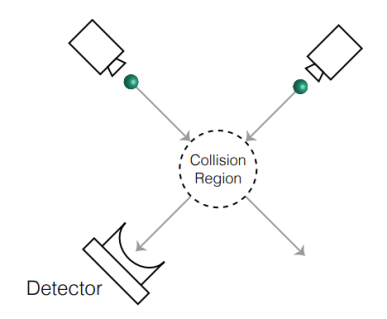
We'd have no issue recognising the path of each ball before, after, and during impact if two particles were bowling balls. If the balls were different colours or masses, it would be evident. Even if the balls were identical in every aspect, we could still track their individual trajectories if we knew their position and velocity at the same time.
But what if the collision occurred between two electrons?
Electrons are identical in every way.
We can't trace their exact paths, according to the uncertainty principle.
We'd never be able to tell which electron enters the detector following a collision.
Because each e wave function has a finite extent, there are overlapping wave functions around the collision zone, and we can't tell which wave function corresponds to which e.
3.1.2 When particles are indistinguishable
QM treatment of 2 e− system must account for indistinguishability. Writing Hamiltonian for 2 electrons requires us to use labels,

In order to maintain indistinguishability, The Hamiltonian must be particle exchange invariant.

If this weren't the case, we'd anticipate detectable changes, which would violate the uncertainty principle.
We must get the same energy with particle exchange:

Define x⃗ = (r, 𝜃, 𝜙, 𝜔) with 𝜔 defined as spin coordinate which can only have values of 𝛼 or 𝛽, that is,  or
or  , respectively.
, respectively.
3.1.3 When particles are indistinguishable
 doesn’t imply that
doesn’t imply that  equal to
equal to  .
.
 is probability density for particle 1 to be at
is probability density for particle 1 to be at  when particle 2 is at
when particle 2 is at  .
. is probability density for particle 1 to be at
is probability density for particle 1 to be at  when particle 2 is at
when particle 2 is at  .
.- These two probabilities are not necessarily the same.
But we require that probability density not depend on how we label particles.
Since  it must hold that
it must hold that

And likewise, that

Both Ψ( ,
, ) and Ψ(
) and Ψ( ) share same energy eigenvalue, E, so any linear combination of Ψ(
) share same energy eigenvalue, E, so any linear combination of Ψ( ,
, ) and Ψ(
) and Ψ( ) will be eigenstate of
) will be eigenstate of  .
.
3.1.4 Particle Exchange Operator
Particle exchange will be carried out by a new operator.

Obviously,  and
and  is not eigenstate of
is not eigenstate of  .
.
Calculating [ ,
, (1, 2)]:
(1, 2)]:
[ ,
, (1, 2)]
(1, 2)]  =
=  (1, 2)
(1, 2) -
-  (1, 2)
(1, 2) 
 (1, 2)
(1, 2)  =
= 
= 0,
Since [ ,
, (1, 2)] =[
(1, 2)] =[ ,
, (2, 1)] =0 eigenstates of
(2, 1)] =0 eigenstates of  and
and  are the same.
are the same.
But  and
and  are not eigenstates of
are not eigenstates of  .
.
Eigenstates of  are some linear combinations of
are some linear combinations of  and
and  that preserve indistinguishability.
that preserve indistinguishability.
3.1.5 Symmetric and Anti-Symmetric Wave functions
We can examine the eigenvalues of 

Since  then
then  but also
but also 
Thus 𝜆2 = 1 and find 2 eigenvalues of  to be 𝜆 = ±1. We can obtain these 2 eigenvalues with 2 possible linear combinations.
to be 𝜆 = ±1. We can obtain these 2 eigenvalues with 2 possible linear combinations.

And

Easy to check that  and
and 
When particles are exchanged, the anti-symmetric wave function changes sign.
No, because when calculating probability or any observable, sign change cancels out.

3.1.6 Symmetric and Anti-Symmetric Wave functions
If you repeat the technique for three identical particles, you will discover

Or

In addition, wave functions for numerous indistinguishable particles must be symmetric or anti-symmetric in terms of particle exchange.
In terms of mathematics, the Schrödinger equation prevents symmetric wave functions from evolving into anti-symmetric wave functions and vice versa.
Under exchange, particles can never modify their symmetric or anti-symmetric behaviour.
3.1.7 Fermions or Bosons
With regards to particle exchange, particles with half-integer spins s = 1/2, 3/2, 5/2,... Are invariably observed to have anti-symmetric wave functions. Fermions are the name given to these particles.
With regards to particle exchange, particles with integer spins s = 0, 1, 2,... Always have symmetric wave functions. Bosons are the name given to these particles.
You'll learn how this rule is derived when you come to relativistic quantum field theory.
For the time being, we will accept this as a quantum mechanics postulate.
3.1.8 Composite Particles
What about a nucleus made up of protons and neutrons, or an atom made up of protons, neutrons, and electrons?
A boson is always a composite particle made up of an even number of fermions and any number of bosons.
A fermion is always an odd number of fermions and any number of bosons.
Identical hydrogen atoms are hence bosons. Note that all hydrogens must be in the same eigenstate to be really similar (or same superposition of eigenstates). In actuality, if you want them to be identical, you'll need extremely low temperatures to get them all in the ground condition.
To use statistics to describe an isolated physical system, we must first make the following assumption:
A microstate, for example, defines the position and momentum of each particle in a classical system of point particles. It determines the value of the wavefunction at every point in space in a quantum mechanical system. You must give the most thorough description you will ever care about to define what microstate the system is in.
You might be thinking if this is a reasonable assumption. What if there aren't any discrete microstates? A classical particle's position and momentum, for example, are continuous rather than discrete. At its most fundamental level, the question of whether the cosmos is discrete or continuous remains unanswered. Fortunately, this turns out not to matter very much. You can always turn a continuous variable into a discrete one by dividing it into very small bins. For the classical particle, we treat all positions between xx and x+δx and all momenta between pp and p+δp as a single microstate.
As long as we choose δx and δp sufficiently small, the exact values turn out to have no effect on most of our results.
This is depicted in Figure 2-1, which depicts the space of possible microstates in one dimension for a single particle. The values of x and p define each microstate. This is known as phase space, and we'll be using it a lot. A 2dN dimensional phase space exists for a system of N particles in dd dimensions. In this phase space, each point (or rather, each tiny volume as depicted in Figure) represents a microstate.
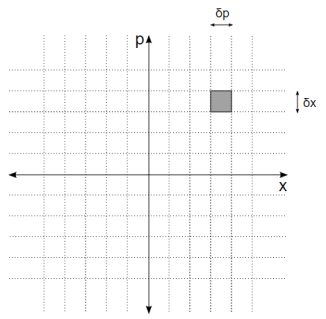
Figure shows the one-dimensional phase space of a single particle. Each axis is segmented into very small intervals. A microstate is a volume defined by the intersection of one interval from each axis.
The number of microstates in ordinary systems is enormous, and they characterise the system in far more detail than humans generally care about. Consider the case of a gas-filled box. You have no means of knowing the exact position and momentum of every single gas molecule, and even if you could, you wouldn't care. Instead, you're usually just concerned with a few macroscopic variables: the system's total energy, the total number of gas molecules, the volume of space it occupies, and so on. These are things that can be measured and are useful in the real world.
The value of each macroscopic variable is used to define a macrostate. It's possible that a large number of microstates belong to the same macrostate. Let's say you want to calculate the total energy and volume of a box of gas. There are a huge variety of different configurations of individual gas molecules that sum up to that amount of energy and volume. You're quite sure the gas is in one of those states, but you're not sure which one.
Key takeaway:
The ratio of the number of microstates in a macrostate to the total number of possible microstates determines the likelihood of discovering it. W (n)/ W (all) = 3/8, for example, is the likelihood of receiving two heads.
Entropy is a measure of a system's randomness (or disorder). It can also be viewed as a measurement of the energy dispersion of the molecules in the system. At a given thermodynamic state, microstates are the number of various potential configurations of molecule position and kinetic energy.
3.3.1 Fermions
Any particle with an odd half-integer spin (such as 1/2, 3/2, and so on) is called a fermion. Fermions include quarks and leptons, as well as most composite particles like protons and neutrons.
The odd half-integer spin has the unintended consequence of obeying the Pauli Exclusion Principle, which means fermions cannot exist in the same state at the same time for reasons we don't fully comprehend.
3.3.2 Bosons
The particles with an integer spin are known as bosons (0, 1, 2...).
All force carrier particles, as well as composite particles containing an even number of fermion particles, are bosons (like mesons).
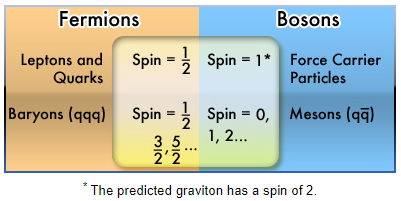
Depending on whether the total number of protons and neutrons in an atom is odd or even, the nucleus is a fermion or a boson. Physicists recently discovered that this has resulted in some odd behaviour in particular atoms under extraordinary settings, such as extremely cold helium.
3.3.3 Difference Between a Fermion and A Boson.
In the entire Universe, there are only two types of fundamental particles: fermions and bosons. Every particle possesses an intrinsic quantity of angular momentum, often known as spin, in addition to the usual attributes such as mass and electric charge. Fermions are particles with spins in half-integer multiples (e.g., 1/2, 3/2, 5/2, etc.) while bosons are particles with spins in integer multiples (e.g., 0, 1, 2, etc.). In the entire known Universe, there are no other forms of particles, basic or composite. But why is this significant? The following is a question from an anonymous reader:
At first look, it may appear that classifying particles based on these characteristics is utterly arbitrary.
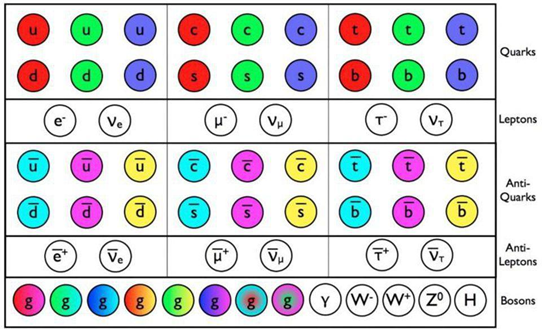
As it turns out, there are a number of little changes in spin that matter, but there are two major ones that impact far more than most people, including physicists, understand.
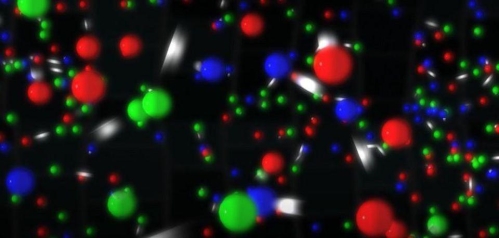
BROOKHAVEN NATIONAL LABORATORY
The first is that fermions are the only particles that have antiparticle counterparts. It's an antiquark if you're wondering what a quark's antiparticle is. The positron (an anti-electron) is the antiparticle of an electron, and a neutrino has an antineutrino. Bosons, on the other hand, are antiparticles of other bosons, and many bosons are their own antiparticle. No such thing as an antiboson exists. What happens if a photon collides with another photon? Is it possible to have a Z0 with another Z0? From a matter-antimatter standpoint, it's just as good as an electron-positron annihilation.
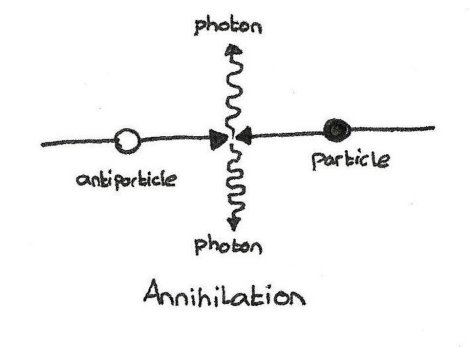
A boson can be its own antiparticle, just like a photon, but fermions.
ANDREW DENISZCZYC, 2017
Composite particles out of fermions: a proton (which is a fermion) is made up of two up quarks and one down quark, whereas a neutron is made up of one up and two down quarks (also a fermion). Because of how spins function, an odd number of fermions together, your new (composite) particle will behave like a fermion, which is why protons and antiprotons exist, and why a neutron differs from an antineutron. However, particles made up of an even number of fermions, such as a quark-antiquark pair (known as a meson), act like a boson. The neutral pion (π0), for instance, is its own antiparticle.
The reason behind this is simple: each of those fermions is a spin ±1/2 particle. If you add two of them together, you can get something that's spin -1, 0, or +1, which is an integer (and hence a boson); if you add three, you can get -3/2, -1/2, +1/2, or +3/2, As a result, it's a fermion. As a result, particle/antiparticle differences are significant. However, there is a second distinction that is arguably much more significant.

Fig 1. The electron energy levels of a neutral oxygen atom in the lowest feasible energy configuration.
CK-12 FOUNDATION AND ADRIGNOLA OF WIKIMEDIA COMMONS
Only fermions, not bosons, are excluded under the Pauli exclusion principle. This rule expressly asserts that no two fermions can occupy the same quantum state in any quantum system. Bosons, on the other hand, are unrestricted. When you add electrons to an atomic nucleus, the first electron will tend to inhabit the ground state, which is the lowest energy state possible. The spin state of that electron can be either +1/2 or -1/2 because it's a spin=1/2 particle. They can no longer fit in the ground state and must progress to the next energy level.
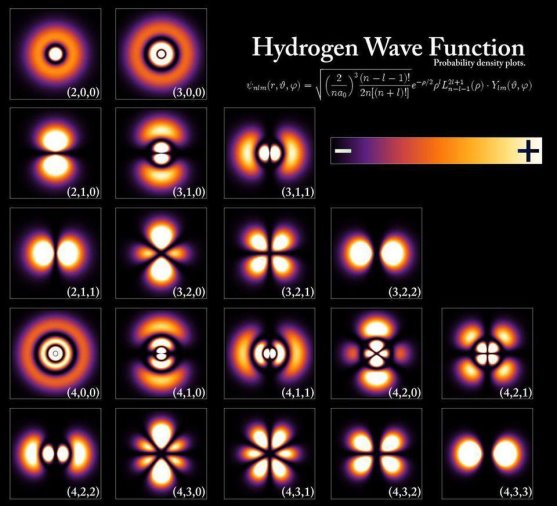
Fig 2. Within a hydrogen atom, the energy levels and electron wavefunctions that correspond to different states.
POORLENO OF WIKIMEDIA COMMONS
That is why the periodic table is set up the way it is. This is why atoms have diverse properties, why they bond together in such complex ways, and why each element in the periodic table is distinct: each type of atom has a different electron configuration than the others. The physical and chemical properties of the elements, the vast variety of molecular configurations we have today, and the basic bonds that allow complex chemistry and life to exist are all due to the fact that no two fermions can occupy the same quantum state.

The way atoms join together to form compounds, such as organic compounds and biological activities.
JENNY MOTTAR
On the other side, you can put as many bosons in the same quantum state as you want! This enables the production of Bose-Einstein condensates, which are extremely rare bosonic states. You can put any number in there by cooling bosons sufficiently such that they fall into the lowest energy quantum state. At low enough temperatures, helium (which is made up of an even number of fermions and hence acts like a boson) becomes a superfluid as a result of Bose-Einstein condensation. Gases, molecules, quasi-particles, and even photons have all been condensed since that time.
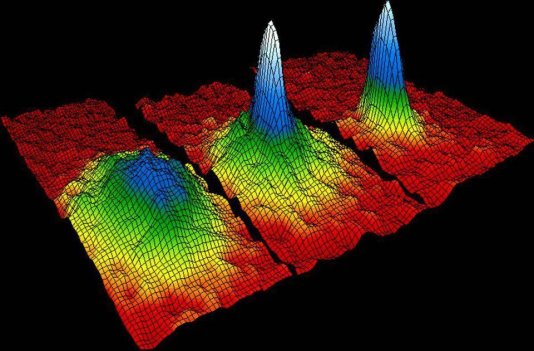
Fig 3. Before (L), during (Middle), and after (R) the... [+] A Bose-Einstein condensate of rubidium atoms before (L), during (Middle), and after (R).
NIST/JILA/CU-BOULDER
White dwarf stars are kept from collapsing under their own gravity by the fact that electrons are fermions; neutron stars are kept from collapsing further by the fact that neutrons are fermions. The Pauli exclusion principle, which governs atomic structure, prevents the densest physical things from turning into black holes.
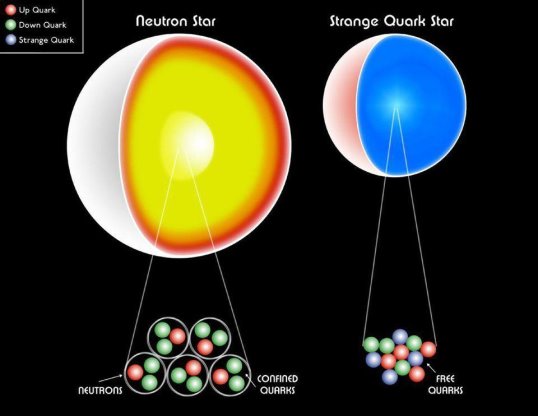
Fig 4. Fermions make up a white dwarf, a neutron star, and even a bizarre quark star.
CXC/M. WEISS
When matter and antimatter annihilate or decay, the quantity of heat released varies depending on whether the particles follow Fermi-Dirac (for fermions) or Bose-Einstein (for bosons) statistics (for bosons). Because of annihilation and these statistics in the early Universe, the cosmic microwave background temperature is 2.73 K today, whereas the cosmic neutrino background temperature is around 0.8 K lower.

Fig 5. The number of neutrino species that must be present to match the CMB fluctuation data.
BRENT FOLLIN, LLOYD KNOX, MARIUS MILLEA, AND ZHEN PANPHYS. REV. LETT. 115, 091301
The fact that fermions have half-integer spin and bosons have integer spin is intriguing, but the fact that these two classes of particles follow different quantum laws is even more intriguing. Those disparities allow us to exist on a fundamental level. For a difference of only 1/2 in a number as commonplace as intrinsic angular momentum, that's not a bad day at the job. However, the far-reaching repercussions of a seemingly quantum rule demonstrate how important spin.
3.4.1 Introduction
The probability density functions, also known as distribution functions, represent the likelihood that particles would occupy the available energy levels in a particular system. While the actual derivation belongs in a statistical thermodynamics course, understanding the underlying assumptions of such derivations, and hence the applicability of the results, is of importance.
The derivation begins with the premise that each potential particle distribution over the available energy levels has the same probability as any other potential distribution that can be separated from the first.
Furthermore, one considers the fact that both the total number of particles and the total energy of the system have a particular value.
Third, one must recognise that various particles behave differently. At any given energy level, only one Fermion can exist (as described by a unique set of quantum numbers including spin). There is no limit to the number of bosons that can occupy the same energy levels. Fermions and bosons have the same "appearance," that is, they are indistinguishable. It is possible to differentiate Maxwellian particles from one another.
Using the Lagrange method of indeterminate constants, the derivation then produces the most likely particle distribution. One of the Lagrange constants, the average energy per particle in the distribution, turns out to be a more important physical quantity than the total energy. The Fermi energy, or EF, is the name for this variable.
The fact that one is dealing with a high number of particles is an important assumption in the derivation. This assumption allows the Stirling approximation to be used to approximate the factorial terms.
The resulting distributions have several unusual properties that are difficult to explain. First and foremost, regardless of whether a specific energy level exists or not, a probability of occupancy can be calculated. Since the density of possible states defines where particles can be in the first place, it seems more reasonable that the distribution function is dependent on it.
The assumption that a given energy level is in thermal equilibrium with a large number of other particles causes the distribution function to be independent of the density of states. It is unnecessary to go into detail on the nature of these particles because their number is so large. The density of states' independence is advantageous since it gives a single distribution function for a wide range of systems.
The image below shows a plot of the three distribution functions, the Fermi-Dirac distribution, the Maxwell-Boltzmann distribution, and the Bose-Einstein distribution, with the Fermi energy set to zero.
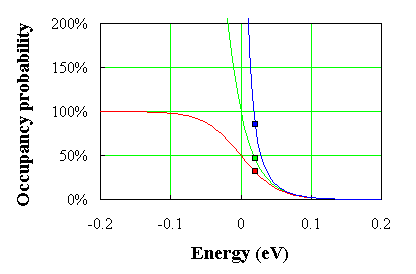
Fig 6. The Fermi-Dirac (red curve), Bose-Einstein (green curve), and Maxwell-Boltzman (blue curve) distributions show occupancy probability versus energy.
For large energies, the three distribution functions are nearly equivalent (more than a few kT beyond the Fermi energy). For energies a few kT below the Fermi energy, the Fermi-Dirac distribution reaches a maximum of 1, whereas the Bose-Einstein distribution diverges at the Fermi energy and has no validity for energies below the Fermi energy.
An example
We now assume a system with equidistant energy levels of 0.5, 1.5, 2.5, 3.5, 4.5, 5.5 eV, each of which can contain two electrons, to better comprehend the general derivation without going through it. Because the electrons are Fermions, they are indistinguishable from one another, and only two electrons (with opposite spin) can occupy the same energy level. This system has 20 electrons, and we set the total energy to 106 eV, which is 6 eV higher than the system's minimum possible energy. There are 24 different and viable setups that satisfy these restrictions. Six of these arrangements are depicted in the diagram below, with the electrons represented by red dots:
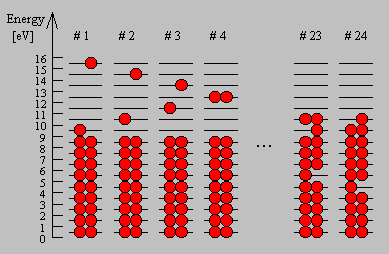
Fig 7. Six of the 24 conceivable configurations with an energy of 106 eV in which 20 electrons can be inserted.
A complete list of the 24 configurations is shown in the table below:

Table: All 24 conceivable configurations with a total energy of 106 eV in which 20 electrons can be placed.
The average occupancy of each energy level over all (and equally likely) 24 configurations is compared to the expected Fermi-Dirac distribution function in the figure below. With a Fermi energy of 9.998 eV and kT = 1.447 eV or T = 16,800 K, the best fit was found. Considering the system's tiny size, the agreement is quite good.
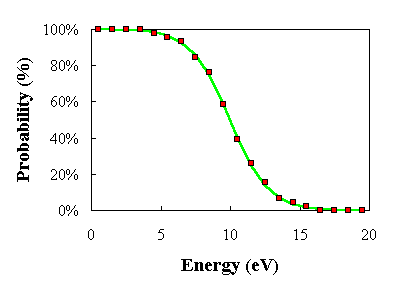
Fig 8. Probability versus energy averaged over the 24 possible configurations of the example (red squares) fitted with a Fermi-Dirac function (green curve) using kT = 1.447 eV and EF= 9.998 eV.
3.4.2 The Fermi-Dirac distribution function
The Fermi-Dirac probability density function calculates the likelihood of a Fermion in thermal equilibrium with a large reservoir occupying a certain energy level. Fermions are particles that have a half-integer spin (1/2, 3/2, 5/2, etc.). The Pauli exclusion principle asserts that only one Fermion can occupy a state specified by its set of quantum numbers n,k,l, and s. This is a unique property of Fermions. As a result, Fermions could alternatively be defined as particles that follow the Pauli exclusion principle. All of these particles have a half-integer spin as well.
Both electrons and holes have a spin of 1/2 and follow Pauli's exclusion principle. These particles will fill the available states in an energy band when they are added to it, just like water fills a bucket. The lowest-energy states are filled first, followed by the next higher-energy levels. The energy levels are all filled up to a maximum energy, which we call the Fermi level, at absolute zero temperature (T = 0 K). There are no states filled above the Fermi level. The transition between entirely filled and completely empty states is gradual rather than sudden at higher temperatures. This behaviour is described by the Fermi function, which is:
 (f18)
(f18)
This function is plotted in the figure below.

Fig 9. The Fermi function at 150 K (red curve), 300 K (blue curve), and 600 K (green curve) (black curve).
For energies that are greater than a few times kT below the Fermi energy, the Fermi function has a value of one. If the energy is equal to the Fermi energy, it equals 1/2, and it drops exponentially for energies a few times kT more than the Fermi energy. While the Fermi function equals a step function at T = 0 K, the transition at finite temperatures and higher temperatures is more gradual.
3.4.3 The Bose-Einstein distribution function

For particles that follow Bose-Einstein statistics, we let the probability of a microstate of energy E in an N-particle system be  . For an isolated system of Bose-Einstein particles, the total probability sum is
. For an isolated system of Bose-Einstein particles, the total probability sum is

We need to find  , the number of ways to assign indistinguishable particles to the quantum states, if any number of particles can occupy the same quantum state.
, the number of ways to assign indistinguishable particles to the quantum states, if any number of particles can occupy the same quantum state.
The number of ways that Ni particles can be allocated to the gi quantum states associated with the energy level I is first considered. We can see that the smallest number of quantum states that can be employed is one; all of the particles can be placed in one quantum state. On the other hand, when each particle has its own quantum state, we can't use more than the Ni quantum states. This task can be viewed as determining the amount of ways we can draw as many gi boxes around Ni spots as possible. Let's make a plan for sketching these boxes. Assume we have a linear frame with a row of spots on it. One particle can be stored in each position. Both ends of the frame are closed. There is a slot between each pair of particle-holding positions, into which a wall can be put. Figure 1 shows a rough sketch of this frame.

Figure 10. Scheme for assigning degenerate energy levels to Bose-Einstein particles.
The frame comprises gi boxes when we place (gi1) walls into these slots. We want to be able to place the walls so that the Ni particles are spread evenly among the gi boxes, allowing us to put any number of particles in any number of boxes. (Of course, the wall placement is constrained by the requirements that we employ at most gi boxes and exactly Ni particles.) This can be accomplished by building the frame with (Ni+gi1) particle-holding sites. Consider the case in which the highest number of particle-holding sites is required. This is the scenario when all Ni particles are contained in a single box.

Figure 11. Ni particles in gi positions have a maximum size frame.
Now we'll look at how many different ways we can fit (gi1) walls into the (Ni+gi1) slots. The initial wall can be placed in any of the slots (Ni+gi1). The second can be used in either the (Ni+gi1(1)) or (Ni+gi2) slots. The last wall can be placed in either the (Ni+gi1(gi2)) or (Ni+1) slots. As a result, the total number of ways to place the (gi1) walls is

Because it contains all permutations of the walls, this total is bigger than the answer we seek. It makes no difference whether a slot is occupied by the first, second, or third wall. As a result, by the factor (gi1)!, which is the number of ways to permute the (gi1) walls, the equation we produced over-counts the quantity we want. As a result, the Ni particles can be allocated to gi quantum states in quantum mechanics.

Ways, and hence

So that the total probability sum for a Bose-Einstein system becomes (via Equation 25.3.1):

To find the Bose-Einstein distribution function, we seek the population set {N1, N2,…, Ni,…} for which WBE is a maximum, subject to the constraints

And

The mnemonic function is

We seek the N⦁i⦁ for which FBEmn is an extremum; that is, the N⦁i⦁ satisfying



Solving for N⦁i⦁, we find

Where the last expression takes advantage of the fact that gi is usually a very large number, so the error introduced by replacing (gi−1) by gi is usually negligible. If 1 ≫  , the Bose-Einstein distribution function reduces to the Boltzmann distribution function.
, the Bose-Einstein distribution function reduces to the Boltzmann distribution function.
Key takeaway:
Fermi–Dirac statistics are used to describe fermions (particles that follow the Pauli exclusion principle), while Bose–Einstein statistics are used to describe bosons. At high temperatures or low concentrations, both Fermi–Dirac and Bose–Einstein statistics become Maxwell–Boltzmann statistics.
The Fermi-Dirac distribution function, often known as the Fermi function, calculates the likelihood of Fermions occupying energy levels. Fermions are half-integer spin particles that follow Pauli's principle of exclusion.
The exotic quantum phenomena of Bose-Einstein condensation was first detected in dilute atomic gases in 1995, and it is currently the focus of extensive theoretical and experimental research.
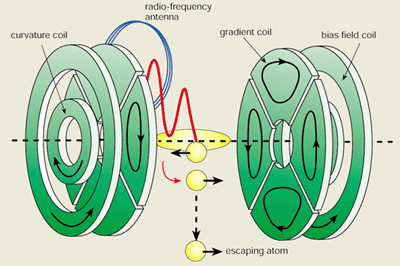
Figure 12. The cloverleaf magnetic trap at MIT is set up for evaporative cooling.
Axial confinement is provided by the middle (curvature) coils, while radial confinement is provided by the outside coils (the "clover leaves" or gradient coils). Cigar-shaped clouds are formed as a result of the anisotropic potential. The most energetic atoms' spins are preferentially flipped by radio-frequency radiation from an antenna, while the remainder atoms rethermalize to a lower temperature. The radio-frequency is lowered to force cooling.
Satyendra Nath Bose, an Indian physicist, wrote Einstein a paper in 1924 in which he calculated the Planck rule for black-body radiation by treating photons as a vapour of identical particles. In the same year, Einstein extended Bose's theory to an ideal gas of identical atoms or molecules, in which the number of particles is conserved, and predicted that the particles would get trapped together in the system's lowest quantum state at sufficiently low temperatures. We now know that Bose-Einstein condensation (BEC) occurs only for “bosons” — particles having a total spin that is an integer multiple of h, the Planck constant divided by 2 pi.
This Bose condensate, as well as the condensation process itself, was predicted to exhibit a variety of odd features, and scientists have been attempting to create Bose-Einstein condensation in the laboratory for years. Finally, in 1995, researchers from the Massachusetts Institute of Technology (MIT) and JILA, a laboratory maintained by the National Institute of Standards and Technology and the University of Colorado in Boulder, Colorado, uncovered convincing evidence for Bose-Einstein condensation in dilute atomic gases.
Since then, the Boulder and MIT teams, as well as a team at Rice University in Houston, Texas, have refined the procedures for making and studying this unique quantum phenomena, and rapid progress has been made in understanding its dynamic and thermodynamic features. At MIT, we recently confirmed the fascinating property of Bose-condensed atoms being "laser-like" — that is, that the atoms' matter waves are coherent. We were able to observe coherence directly in these experiments, and we developed a crude "atom laser" that generates a beam of coherent atoms, similar to how an optical laser emits coherent photons. Simultaneously, theorists have addressed a number of fundamental difficulties and devised effective ways for simulating real-world systems.
3.5.1 Order reigns in the ground state
The dynamical behaviour of a gas at room temperature is not affected by the fact that one atom cannot be distinguished from another. In accordance with the Heisenberg uncertainty principle, the position of an atom is smeared out over a distance given by the thermal de Broglie wavelength, λdB = (2 pi h-bar2 / kBmT)1/2, where kB is the Boltzmann constant, m is the atomic mass and T is the temperature of the gas. At room temperature the de Broglie wavelength is typically about ten thousand times smaller than the average spacing between the atoms. This means that the matter waves of the individual atoms are uncorrelated or “disordered”, and the gas can thus be described by classical Boltzmann statistics.
As the gas is cooled, however, the smearing increases, and eventually there is more than one atom in each cube of dimension λdB. The wavefunctions of adjacent atoms then “overlap”, causing the atoms to lose their identity, and the behaviour of the gas is now governed by quantum statistics.
Bose-Einstein statistics dramatically increase the chances of finding more than one atom in the same state, and we can think of the matter waves in a Bose gas as “oscillating in concert”. The result is Bose-Einstein condensation, a macroscopic occupation of the ground state of the gas. (In contrast, fermions – particles with a total spin of (n + ½)h, where n is an integer – cannot occupy the same quantum state.) Einstein described the process as condensation without interactions, making it an important paradigm of quantum statistical mechanics.
The density distribution of the condensate is represented by a single macroscopic wavefunction with a well-defined amplitude and phase, just as for a classical field. Indeed, the transition from disordered to coherent matter waves can be compared to the change from incoherent to laser light.
3.5.2 Chilling the atoms
Bose-Einstein condensation has been cited as an important phenomenon in many areas of physics, but until recently the only evidence for condensation came from studies of superfluid liquid helium and excitons in semiconductors. In the case of liquid helium, however, the strong interactions that exist in a liquid qualitatively alter the nature of the transition. For this reason, a long-standing goal in atomic physics has been to achieve BEC in a dilute atomic gas. The challenge was to cool the gases to temperatures around or below one microkelvin, while preventing the atoms from condensing into a solid or a liquid.
Efforts to Bose condense atoms began with hydrogen more than 15 years ago. In these experiments hydrogen atoms are first cooled in a dilution refrigerator, then trapped by a magnetic field and further cooled by evaporation (see below). This approach has come very close to observing BEC, but is limited by the recombination of individual atoms to form molecules and by the detection efficiency.
In the 1980s laser-based techniques such as Doppler cooling, polarization-gradient cooling and magneto-optical trapping were developed to cool and trap atoms. These techniques profoundly changed the nature of atomic physics and provided a new route to ultracold temperatures that does not involve cryogenics. Atoms at sub-millikelvin temperatures are now routinely used in a variety of experiments. Alkali atoms are well suited to laser-based methods because their optical transitions can be excited by available lasers and because they have a favourable internal energy-level structure for cooling to low temperatures.
However, the lowest temperature that these laser cooling techniques can reach is limited by the energy of a single photon. As a result, the “phase-space density” – the number of atoms within a volume lambdadB3 – is typically about a million times lower than is needed for BEC.
The successful route to BEC turned out to be a marriage of the cooling techniques developed for hydrogen and those for the alkalis: an alkali vapour is first laser cooled and then evaporatively cooled. In evaporative cooling, high-energy atoms are allowed to escape from the sample so that the average energy of the remaining atoms is reduced. Elastic collisions redistribute the energy among the atoms such that the velocity distribution reassumes a Maxwell-Boltzmann form, but at a lower temperature. This is the same evaporation process that happens when tea cools, but the extra trick for trapped atoms is that the threshold energy can be gradually lowered. This allows the atomic sample to be cooled by many orders of magnitude, with the only drawback being that the number of trapped atoms is reduced.
The challenge in combining these two cooling schemes for alkalis was a question of atomic density. Optical methods work best at low densities, where the laser light is not completely absorbed by the sample. Evaporation, on the other hand, requires high atomic densities to ensure rapid rethermalization and cooling. This changed the emphasis for optical methods: while they had previously been used to produce low temperatures and high phase-space density simultaneously, they now needed to produce high elastic collision rates. Furthermore, this had to be achieved in an ultrahigh vacuum chamber to prolong the lifetime of the trapped gas. Thus no new concept was needed to achieve BEC, but rather it was an experimental challenge to improve and optimise existing techniques. These developments were pursued mainly at MIT and Boulder from the early 1990s.
3.5.3 Improved techniques in magnetic trapping
For evaporative cooling to work, the atoms must be thermally isolated from their surroundings. This must be done with electromagnetic fields, since at ultracold temperatures atoms stick to all surfaces. The best method for alkalis is magnetic confinement, which takes advantage of the magnetic moment of alkali atoms. After the atoms are trapped and cooled with lasers, all light is extinguished and a potential is built up around the atoms with an inhomogeneous magnetic field. This confines the atoms to a small region of space.
Atoms can only be cooled by evaporation if the time needed for rethermalization is much shorter than the lifetime of an atom in the trap. This requires a trap with tight confinement, since this allows high densities and hence fast rethermalization times. For this reason, the first experiments that observed BEC used so-called linear quadrupole traps, which have the steepest possible magnetic fields.

Figure 13: At MIT, dispersive light scattering (phase-contrast imaging) was used to observe the development of a Bose condensate in a direct and non-destructive way.
The intensity of dispersed light is plotted as a function of trap position, which is proportional to the atom column density along the line of sight. The cloud has been cooled to just above the BEC transition temperature in the figure on the left, and the atom distribution is practically classical. A strong peak of atoms appears at the trap centre (middle) as the temperature is decreased across the phase transition, and further cooling increases the condensate fraction to nearly 100%. (right).
These approaches do create great densities and rapid evaporation, but they have one fundamental flaw: the magnetic field at the centre is zero, causing an atom to become "disoriented" and lose its magnetic moment's alignment. These "spin flips" result in a calamitous loss of atoms from the trap since a magnetic field can only confine atoms with magnetic moments that are antiparallel to the field. Both the Boulder and MIT teams devised solutions to the challenge. A rotating magnetic field was created by the Boulder group to keep the atoms away from the "hole," while we "plugged" the hole using the repulsive force of a focused laser beam.
Both of these methods were successful, yet they both had significant flaws. We discovered BEC in an unique "cloverleaf" magnetic trap that overcome these restrictions in March 1996. This trap is a modification of the Ioffe-Pritchard trap, which was first proposed in 1983 and contains a non-zero magnetic field at its centre to prevent atom loss. The confinement is tight in two directions but weak in the third, resulting in cigar-shaped trapped clouds rather than spherical trapped clouds. The trap's unique feature is the coils' "cloverleaf" winding arrangement, which provides good optical access to the sample for laser cooling and trapping, as well as probing the condensate (see figure 1). The trap's design has proven to be dependable and versatile, and it was used to gather the majority of the experimental results shown here. Given the amount of effort that has gone into trap design in recent years, it's remarkable that the best setup has been around for almost 13 years.
Using electron spin resonance, evaporation can be easily accomplished in a magnetic trap. Applying a radio-frequency field in resonance with the energy difference between the spin-up and spin-down states flips the magnetic moments of trapped atoms. The field's frequency is set such that it only impacts the atoms at the cloud's edge, which have the most energy in a harmonic oscillator potential. The magnetic forces become anti-trapping and the atoms are freed from the trap when the moments of these atoms are inverted. Because the cloud cools and shrinks towards the trap's centre, the frequency of the radio-frequency field must be decreased to keep evaporation at the cloud's perimeter.
In our trials, sodium atoms are ejected from an oven at 600 K (800 m s-1) and a density of around 1014 cm-3. The atoms are initially slowed to a speed of roughly 30 m s-1 over a distance of 0.5 m using a laser beam. Around 1010 atoms can be trapped in a magneto-optical trap at this speed. The temperature of the gas is reduced to roughly 100 K using laser cooling and trapping techniques, which is cold enough for the atoms to be trapped with magnetic fields. In about 20 seconds, evaporation cools the gas to about 2 K, the temperature at which a condensate develops.
The density of atoms at condensation is approximately 1014 cm-3, which is similar to that of the atomic beam oven. As a result of the cooling sequence, the temperature is reduced by 8 to 9 orders of magnitude. We normally lose a factor of 1000 atoms during evaporative cooling and generate condensates with 107 atoms. Condensates in the cloverleaf trap can be up to 0.3 mm long. As a result of condensation, we now have macroscopic quantum objects.
3.5.4 Observing condensation
Condensates trapped in the trap are very tiny and optically thick, making them difficult to see. By turning off the trap and letting the atoms to expand ballistically, the first observations of BEC were made. After that, a laser beam in resonance with an atomic transition was flashed on, and the subsequent light absorption generated a "shadow" that was captured by a camera. This picture of atomic locations records the velocity distribution of the atoms since they were released from the trap. Because the atoms in the condensate are in the lowest energy state, they expand very little, and the dramatic mark of Bose condensation was thus the abrupt development of a prominent peak of atoms in the image's centre.
Because the atoms are freed from the trap, absorption imaging is fundamentally destructive. Furthermore, the atoms are heated by the absorbed photons. In early 1996, we used "dark-ground" imaging, a technique that depends on dispersion rather than absorption, to examine a Bose condensate non-destructively.
A complicated index of refraction can be used to characterise both dispersion and absorption. The absorption of photons from the probe beam is described by the imaginary part of the index, which is followed by inelastic scattering of light over high angles. Coherent elastic scattering over small angles corresponds to the real part. The phase of the light is altered by dispersive scattering, and because the light is only slightly deflected, the technique is nearly non-perturbative. The crucial point is that if the probing laser is detuned far enough away from any atomic resonances, dispersive scattering dominates absorption, and the condensate resembles a piece of shaped glass, or a lens.
The phase shift induced by the atoms must be converted into an intensity variation in order to “see” the condensate using dispersive scattering. This is a well-known optical problem that can be solved by spatial filtering. Opaque objects (“dark-ground imaging”) or phase-shifters (“phase-contrast imaging”) are used to alter the signal in the Fourier plane.
Because dispersive imaging is non-destructive, many photographs of the same condensate can be acquired. Figure 2 shows phase-contrast imaging of the development of a condensate. Such real-time pictures will be essential in researching a condensate's dynamical behaviour.
3.5.5 Theory and first experiments
The theoretical study of trapped weakly interacting Bose gases has a long history, dating back to Gross and Pitaevskii's ground breaking work on the macroscopic wavefunction for such systems in the 1950s. The number of papers devoted to the idea of trapped Bose gases has increased dramatically in the last year, indicating the numerous unanswered and intriguing topics that have piqued the scientific community's attention.
The theoretical research can be divided into two categories. On the one hand, the "many-body problem" is solved in the case of many atoms inhabiting the ground state. The goal is to figure out how interatomic forces affect condensate structural features such ground state configuration, dynamics, and thermodynamics. The study of coherence and superfluid effects in these unique systems is the second topic of great interest.
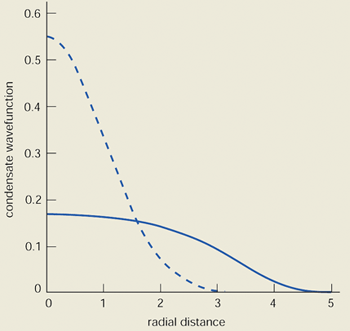
Figure 14: For a cloud of 5000 rubidium atoms, a theoretical computation of the condensate wavefunction versus radial co-ordinate was performed.
The solid line represents the solution of the Gross-Pitaevskii equation, which is the Schrodinger equation with two-body collisions included, while the dashed line is a non-interacting cloud prediction.
The new availability of experimental data has sparked theoretical analyses of structural characteristics. Because collisions only occur between pairs of atoms in a dilute Bose gas, interaction effects are simplified and may be described using a single parameter, the s-wave scattering length (which in most cases is a distance comparable with the range of the interaction). The intricate interactions that exist in liquid helium are in sharp contrast to this setting.
However, a key finding from recent theoretical work is that two-body interatomic forces in condensates can be extremely strong, even when the gas is dilute. The significance of interactions in the Schrödinger equation for the condensate wavefunction is determined by the amount of the interaction energy per atom compared to the harmonic trap's ground-state energy. This ratio is determined by the ratio Na/aHO, where an is the s-wave scattering length, aHO is the oscillation amplitude of a particle in the ground state, and N is the number of atoms. Although a/aHO is normally around 10-3, N can be as high as 107, so interactions can significantly alter the ground-state wavefunction and energy (see figure 3). Experiments at both Boulder and MIT have confirmed the predicted relation of energy on the number of atoms.
The normal modes of oscillation of a Bose condensate can be investigated using the time-dependent Schrödinger equation. These are equivalent to the phonon and roton excitations in super fluids, which have been widely researched. Understanding collective quantum excitations has long been important in describing the features of superfluid liquid helium, and pioneering work by Lev Landau, Nikolai Bogoliubov, and Richard Feynman has contributed to this understanding (see Donnelly in Further reading).

Figure 15: At MIT, shape oscillations of a Bose condensate were observed.
The cloud was then allowed to oscillate freely for a varied time ranging from 16 ms (left) to 48 ms after the trapping potential was disrupted with a time-dependent field (right). By turning off the trap and allowing the atoms to grow ballistically for 40 milliseconds, the clouds were observed.
The equations of motion for a confined Bose gas have a form that Bogoliubov derived in 1947, and these have recently been intensively investigated. The equations take the simple form of the superfluid hydrodynamic equations when the parameter Na/aHO is very big. The frequency, omega, of quantum excitations in an isotropic harmonic-trapping potential is found to follow the dispersion law omega = omega0(2n2 + 2nl + 3n + l)1/2, where omega0 is the trap frequency, n is the number of nodes in the wavefunction along a trap radius, and l is the angular momentum carried by the excitation. For particles that do not interact, this should be compared to omega = omega0(2n + l). The interactions play a crucial role in the "surface" modes (n = 0), where they reduce the excitation energies from omega = omega0l to omega = omega0l1/2.
For anisotropic traps, the hydrodynamic equations can also be solved analytically, providing useful predictions for the experiments at Boulder and MIT. Condensates were gently "shaken" in these studies by changing magnetic trapping fields, causing oscillations in the form of the condensate. For a cigar-shaped cloud, the mode indicated in figure 4 is analogous to a quadrupole oscillation: contraction in the long direction is followed by expansion in the short direction, and vice versa. Experiments at MIT confirmed the theoretical prediction of this mode's frequency to within 1%. Indeed, the most remarkable and persuasive demonstration of the relevance of contacts in condensates has come from measurements of internal energy and the frequency of collective excitations carried out at both Boulder and MIT.
When the temperature approaches the BEC transition temperature, the consequences of two-body interactions become less important. This is because atoms become thermally stimulated and spread out, resulting in a gas that is considerably more dilute than the condensate. The predictions for a non-interacting gas for the transition temperature kBT0 = 0.94h-bar omega0 N1/3 and the "condensate fraction" – the percent of atoms that are condensed – N0/N = 1 -(T/T0)3 are not greatly impacted by interactions, according to early observations at MIT.
Theoretically, interactions should affect both T0 and N0/N, and these effects should be visible using high-precision measurements of both values. A change of N0 compatible with theoretical expectation has been detected at Boulder, but this change is comparable to the measurement uncertainty (figure 5). In general, the thermodynamic behaviour of trapped Bose gases differs from that of uniform (constant density) gases in fascinating ways. Interactions in a uniform gas boost T0, whereas interactions in a confined gas lower it.
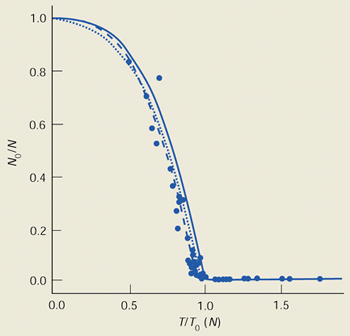
Figure 16: Condensate fraction, N0/N, measured as a function of scaled temperature, T/T0, at Boulder.
T0 is the predicted critical temperature for an ideal gas in a harmonic trap in the thermodynamic limit (many atoms). The solid curve is the predicted dependence in the thermodynamic limit, and the dotted curve includes a correction for the finite number of atoms (4000) in the condensate. To the uncertainties in the data, the measurement is consistent with the theory for non-interacting bosons. The dashed line is a best fit to the experimental data.
Many theoretical questions for trapped Bose gases remain to be explored and understood. Two major issues concerning collective excitations are the treatment of oscillations near to T0 and the mechanisms by which oscillations are damped, particularly at low temperatures. Related questions concern nonlinear effects in excitations, the onset of chaotic phenomena and the variation of excitation frequencies with temperature.
An important problem is the behaviour of trapped gases with negative s-wave scattering lengths. In the experiments at MIT and Boulder the scattering lengths are positive. This means that the effect of the two-body collisions is to cause repulsion between the atoms (“hard-sphere” collisions), and in such an instance it is theoretically well understood that a Bose condensate is stable. For negative scattering lengths, however, the forces between the atoms are attractive and tend to cause a condensate to collapse. This is believed to prevent condensation completely in a uniform system and restrict the number of atoms that can be condensed in an inhomogeneous system such as a trap. Measurements of BEC in lithium have been carried out at Rice University and the number of condensed atoms is consistent with theory.
As mentioned above, the property of superfluidity (i.e. persistent flow without viscous damping) is closely related to the existence of long-range order, or coherence, in the ground state. Indeed, the superfluid velocity is proportional to the gradient of the phase of the ground-state wavefunction. This implies, for example, that the moment of inertia of a Bose gas below T0 differs from that expected for a rigid body. Superfluidity and coherence phenomena will become challenging areas for future research. Theorists have already made quantitative predictions for the Josephson-type effects and interference phenomena associated with the phase of the condensate wavefunction. The role of vortices in the dynamics of the system, the possible occurrence of “second sound”, and the interplay between collective excitations, rotational properties and superfluidity are further problems of fundamental interest.
3.5.6 Realization of a basic atom laser
The possibility of producing a coherent beam of atoms, which could be collimated to travel large distances or brought to a tiny focus like an optical laser, has sparked the imagination of atomic physicists. Such an atom laser could have a major impact on the fields of atom optics, atom lithography and precision measurements.
A Bose-Einstein condensate is a sample of coherent atomic matter and is thus a good starting point for an atom laser. The process of condensing atoms into the ground state of a magnetic trap is analogous to stimulated emission into a single mode of an optical laser and one can think of the trap as a resonator with “magnetic mirrors”. An important feature of a laser is an output coupler to extract a fraction of the coherent field in a controlled way, and at MIT we recently demonstrated such a device for a trapped Bose gas.
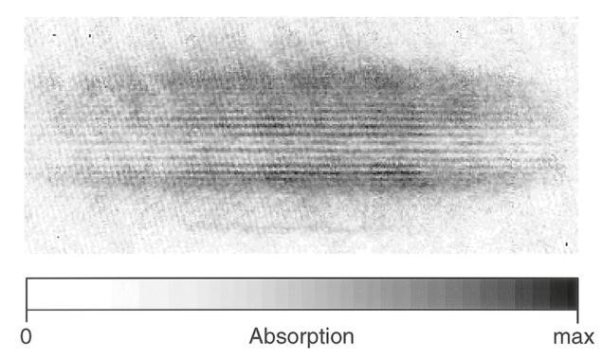
Figure 17: Two overlapping condensates form an interference pattern.
This image depicts raw data and was captured in absorption. The tiny, straight striations have a period of 15 m and are fringes caused by matter-wave interference. The ballistic expansion from a harmonic double-well potential is responsible for the significantly bigger modulations in the cloud structure.
Because a magnetic trap can only confine atoms with magnetic moments that are antiparallel to the magnetic field, we changed the “reflectivity” of the magnetic mirrors by tilting the atoms' magnetic moments using a short radio-frequency pulse. The atoms were removed in this manner, accelerated under gravity, and absorption imaging was used to examine them. The extracted fraction may be changed between 0% and 100% by altering the amplitude of the radio-frequency field (see Physics World 1996 October p18).
The coherence of a laser's output, or the presence of a macroscopic wave, is an important aspect. Coherence has been utilised as a defining condition for BEC in theoretical treatments. However, none of the measurements detailed thus far have shown long-range order. Although collective measurements match with Schrödinger equation solutions at zero temperature, identical frequencies have been anticipated for a classical gas in the hydrodynamic regime.
Examining the impacts of the phase of the condensate wavefunction is one way to explore coherence. The Josephson effect has been used to see this phase in superconductors, and the motion of quantized vortices in liquid helium has been used to infer it. Because phase is a complex number, it can only be recognised as an interference effect between two different wavefunctions, similar to how interference between two independent laser beams may be detected. Theoretical work on coherence and the interference features of confined Bose gases has recently gotten a lot of interest. The theoretical issues that lie beneath are of great interest and concern. For example, can spontaneous symmetry breaking (an important topic in physics) apply in systems with few atoms, and what impact do particle-particle interactions have on the phase of the condensate ("phase diffusion")?
We recently witnessed high-contrast interference of two separate Bose condensates at MIT, demonstrating that a condensate has a well-defined phase. By concentrating a sheet of light into the cloverleaf trap and repelling atoms from the centre, we created a double-well trapping potential. Evaporation resulted in the formation of two distinct condensates. These were left to free-fall and expand ballistically under gravity.
The clouds overlapped horizontally after lowering 1 cm, and absorption revealed the interference pattern (figure 6). The fringes have a period of 15 p.m., which matches the respective de Broglie wavelengths of the overlapping clouds. When the imaging system's resolving power is taken into account, the intensity difference between the light and dark fringes indicate that the atomic interference modulation was between 50% and 100%. Figure 6 has the unique feature of being a real-time snapshot showing interference. The wavefront of a single particle is separated and then recombined in classic experiments to demonstrate the wave aspect of matter, and this is repeated numerous times to build up an interference pattern.
Using the radio-frequency output coupler, high-contrast interference was also detected between two pulses of atoms taken from a double condensate. This is a basic instantiation of an atom laser, demonstrating that a coherent beam of atoms may be extracted from a Bose condensate.
3.5.7 Where do we go next?
Bose-Einstein condensation has given us not only a new type of quantum matter, but also a one-of-a-kind source of ultracold atoms. Evaporative cooling has made nanokelvin temperatures accessible to researchers, and with additional optimization, condensates of 108 atoms could be attainable at durations of 5-10 seconds. This pace of creation is comparable to that of a typical light trap, indicating that Bose condensation could eventually replace the magneto-optical trap as the primary bright source of ultracold atoms for precision investigations and matter-wave interferometry.
To date, the experiments have looked at some of the fundamental features of condensation and found good agreement with theory. The discovery of phase coherence in BEC represents a major step forward in the development of coherent atomic beams. However, there are still a number of fundamental concerns that can only be answered by experiments, particularly in the area of Bose gas dynamics, such as the production of vortices and superfluidity.
Exploration of additional atomic systems is another major direction. Rice's lithium research has paved the way for a better understanding of Bose gases with negative scattering lengths. “Sympathetic cooling” produced two different forms of condensate in the same trap at Boulder recently. In this system, a cloud of rubidium atoms in one energy level was cooled through evaporation as normal, while a second cloud of atoms in a different energy state was cooled through thermal contact with the first cloud. Ultracold temperatures will be accessible to atoms that are not well suited to evaporation, such as fermionic atoms whose elastic scattering rate vanishes at low temperatures or uncommon isotopes that can only be confined in small numbers, as a result of this cooling of one species by another. Fermions do not condense, but cooling them into the quantum statistics domain could reveal new information on Cooper pairing and superconductivity.
It's always interesting when physics subfields collide. Individual atoms or interactions between a few atoms have historically been the focus of atomic physics. With the establishment of BEC in dilute atomic gases, we can now study many-body physics and quantum statistical effects with the precision of atomic physics experiments, and it's thrilling to see how quickly these new quantum gases are being explored.
3.6.1 How to see Planck's radiation law as a consequence of Bose Einstein statistics?
Planck's law is the result of the following factors.
1) The mode density per unit volume in a cavity is 8πυ2/c3.
2) Within each mode, assume Boltzmann statistics i.e the probability of having an energy E is given by p(E) ∝ e-E/kT
3) Ask that the energies E be discretized as nhν instead of continuous. Essentially, the difference between doing  and the sum
and the sum  , where
, where  gives Planck's law.
gives Planck's law.

So far, it's a nice trick to go to the discrete sum but that's all that was done. There is no sense in which the particles are indistinguishable etc.
What is the correct modern way of seeing this result? I assume the starting point is that we have an ideal gas of photons inside a blackbody cavity and they follow statistics that yield  but how exactly does one go from there to Planck's law?
but how exactly does one go from there to Planck's law?
As you mentioned, we use a cavity as a model for blackbody radiation, for which you have already determined the mode density.

The photons' energies are discretized and have the formula E=nhv, where nn is an integer. The grand-canonical partition function for bosons with vanishing chemical potential will now be written down. Because photons interact with the cavity's walls, the number of photons isn't constant, it's taken to be zero. For a given frequency 0 the partition function is The energies that photons can have are discretized and have the formula E=nh, where nn is a positive integer. The grand-canonical partition function for bosons with vanishing chemical potential will now be written down. Because photons interact with the cavity's walls, the number of photons isn't constant, it's taken to be zero. For a given frequency 0 the partition function is

The total partition function can then be obtained by multiplying all of the frequency partition functions together.

Taking the logarithm of ΞΞ will transform the product in a sum

Which can be modified in an integral if the difference in frequency between two consecutive frequencies becomes minuscule. We can delegate this task to the density of modes g(v) instead of counting the number of photons per frequency:

You can now calculate the energy associated using 
So

And from the relation  you find that
you find that

3.6.2 Theory:
According to Max Planck,19–21 a blackbody is a collection of numbers of oscillators. An oscillator emits or absorbs energy proportional to its oscillation frequency. Thus, emission or absorption of energy of a blackbody is discrete rather continuous which is termed as quantization of energy. This concept of quantization of electromagnetic radiation is used to explain the energy density distribution nature of a blackbody.
On the other hand, Louis de Broggle proposed that every moving object has a wave-particle dual character.12 According to the de Broggle, wavelength (λ) of a particle having momentum p, is hp, where h is the Planck’s constant. Since oscillators are in motion and have momentum, they should have de Broggle wavelength.
Following Planck’s postulate,22 let us consider that the number of identical resonators per unit volume of a blackbody, having oscillation frequency ν, is N at the equilibrium temperature (T). If U is the vibrational energy of a resonator, the total energy per unit volume is NU. It is known that the rate of change of vibrational entropy, S, with respect to the change of vibrational energy, U, at a temperature T is –

If Ni number of particles occupy the ith vibrational state, the total energy of these particles are

For frequency vi, the number of modes per unit volume is 82ic38i2c3. In this case, the total energy per unit volume for this frequency is calculated using the equipartition principle (classical technique).

Comparing Equation (2) and (3) we get an expression for the number of particles at ith vibrational state which is

Where v0 is the ground state vibrational energy's frequency. Equation can be used to compute a system's total internal energy (U) (4). The total energy per unit volume (U) of a system is equal to the number of particles per unit volume (N).

From Equation (5) we get

Or,
DU = BkdT (7)
Where,

Putting the value of dU in Equation (1) we get
DS = Bkd (ln T) (9)
On the integration of Equation (9), we get
S = Bkln T (10)
Because, for an ideal system, entropy is zero at 0K according to the third law of thermodynamics. It is also known that the thermal entropy is zero at the Bose-Einstein Condensate temperature.23,24
Following the Planck’s derivation22 of the entropy of an oscillator, we get

Where ν is the frequency of the oscillator. Equation (11) may be rearranged as

Comparing equation (10) and equation (12) we get

Equation (13) is also valid for ν0. If T0K is the Bose-Einstein condensate temperature of the system, then at T0K temperature all the oscillators should exist in the ground vibrational state. Thus, from Equation (13) we get

From equation (5) we get

Let,

Where,

Putting this value of Uhν0Uhν0 in equation (14) we get the Bose-Einstein condensate temperature of the system of interest in terms of Z and B, which is

It is impossible to find the value of T0 unless Z and B are known. But, we can study the variation of T0 with the changes of Z and B.
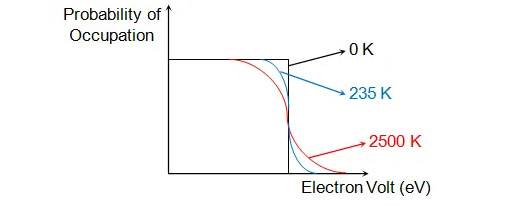
Fig 18. Fermi-Dirac distribution function at different temperatures
The electrons have little energy and hence inhabit lower energy states at T = 0 K. The Fermi-level is the highest energy state among these inhabited levels. As a result, electrons do not occupy any energy levels above the Fermi level. As a result, as indicated by the black curve in Figure, we get a step function that defines the Fermi-Dirac distribution function.
However, when the temperature rises, the electrons gather more and more energy, eventually reaching the conduction band. As a result, at higher temperatures, it is difficult to discriminate between the occupied and unoccupied states, as seen by the blue and red curves in Figure.
The free electrons in a solid crystal have different energies. According to quantum theory, free electrons continually occupy distinct energy levels at absolute zero temperature, with no gaps between filled states. Dropping the free electrons of a metal one by one into the potential well demonstrates this. The first electron to be dropped would occupy the lowest accessible energy level, say E0, and the following electron would do the same. The following energy level would be occupied by the third electron. Because of Pauli's exclusion principle, the third electron dropped would occupy the energy level E1 (>E0), and so on. If there are N (even) electrons in the metal, they will be dispersed in the first N/2 energy levels, with the higher energy levels being completely empty, as seen in Fig.
Figure Distribution of electrons in various energy levels at 0 K.
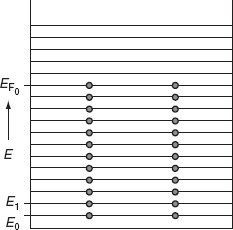
The highest filled level, which separates the filled and empty levels at 0 K is known as the Fermi level and the energy corresponding to this level is called Fermi energy (EF). Fermi energy can also be defined as the highest energy possessed by an electron in the material at 0 K. At 0 K, the Fermi energy EF is represented as EF0. As the temperature of the metal is increased from 0 K to TK, then those electrons which are present up to a depth of KBT from Fermi energy may take thermal energies equal to KBT and occupy higher energy levels, whereas the electrons present in the lower energy levels i.e., below KBT from Fermi level, will not take thermal energies because they will not find vacant electron states.
The probability that a particular quantum state at energy E is filled with an electron is given by Fermi-Dirac distribution function f(E), given by:

A graph has been plotted between f(E) and E, at different temperatures 0 K, T1 K, T2 K, T3 K.
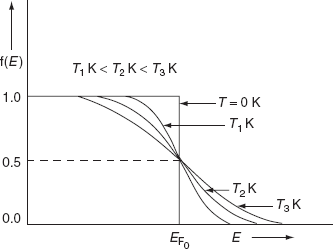
Analytical Treatment At 0 K: Substitute T = 0 K in the Fermi-Dirac distribution, we have

= 0 for E > EF
The curve has step-like character with f(E) = 1 for energies below EF0 and f(E) = 0 for energies above EF0. This represents that all the energy states below EF0 are filled with electrons and all those above it are empty.
At T > 0 K

> 0 for E > EF
= ½ for E = EF
As the temperature is raised from absolute zero to T1K, the distribution curve begins to departs from step-like function and tails off smoothly to zero. Again with a further increase in temperature to T2K and to T3K, the departure and tailing of the curves increases. This indicates that more and more electrons may occupy higher energy states with an increase of temperature and as a consequence the number of vacancies below the Fermi level increases in the same proportion. At non-zero temperatures, all these curves pass through a point whose f(E) =1/2, at E = EF . So EF lies half way between the filled and empty states.
In physics, a degenerate gas is a particular configuration of a gas made up of subatomic particles with half-integral intrinsic angular momentum that is frequently obtained at high densities (spin). Fermions are particles whose microscopic behaviour is governed by a set of quantum mechanical principles known as Fermi-Dirac statistics (q.v.). These principles specify, for example, that any quantum-mechanical state of a system can only have one fermion. Because the lower-energy states have all been filled, the extra fermions are forced to inhabit states of higher and higher energy as particle density rises. The pressure of the fermion gas rises as the higher-energy states gradually fill in, a phenomenon known as degeneracy pressure. A fully degenerate, or zero-temperature, fermion gas is one in which all of the energy levels below a certain value (named Fermi energy) are filled. All fermions, including electrons, protons, neutrons, and neutrinos, follow Fermi-Dirac statistics. Degenerate electron gas can be found in common metals and in the interiors of white dwarf stars, for example.
We'll look at a gas of fermions in the degenerate regime, where the density n exceeds the quantum density n q by a large factor, or when the Fermi energy exceeds the temperature by a large factor. We've seen that for such a gas, is positive, therefore we'll focus on the Fermi energy EF, which is near to its T=0 value.
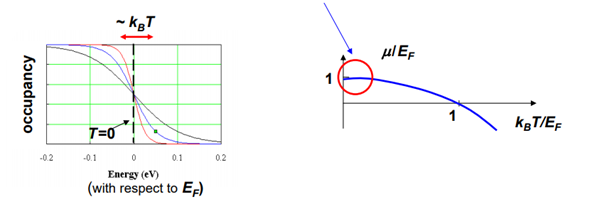

The electron gas in metals and white dwarf stars is the most important degenerate Fermi gas. Another example is a neutron star with such a high density that the neutron gas is degenerate.
3.8.1 Degenerate Fermi Gas in Metals
The mobile electrons in the conduction band that can participate in charge transport are considered. The energy is measured from the conduction band's bottom. When metal atoms come together, their outer electrons separate and are free to flow through the solid. With the concentration of beneficial metals ~ 1 electron/ion, the density of electrons in the conduction band n ~ 1 electron per (0.2 nm) 3 ~ 1029 electrons/m 3 .
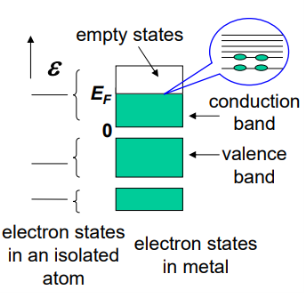
The net Coulomb attraction to the positive ions prevents electrons from escaping from the metal; the energy required for an electron to escape (the work function) is typically a few eV. The electrons in a perfect Fermi gas are trapped between impenetrable walls, according to the model.
Why may this dense gas be treated as ideal? Indeed, at this density, Coulomb interactions between electrons must be exceedingly strong, because electrons in a solid travel in the strong electric fields of positive ions. Landau's Fermi liquid theory addresses the first problem. The response to the second issue is that, while the ion field changes the density of states and the effective mass of electrons, it has no influence on the ideal gas approximation's validity. Thus, in the case of “simple” metals, it is reasonable to treat mobile charge carriers as electrons with mass renormalized slightly by interactions. However, there are situations when interactions result in mass enhancements of 100-1000 times (“heavy fermions”).
3.8.2 The Fermi Energy
The density of states per unit volume for a 3D free electron gas (m is the electron mass):

The number of electron per unit volume:

At T = 0, all the states up to ε = EF are filled, at ε> EF – empty:



The Fermi energy (μ of an ideal Fermi gas at T=0)
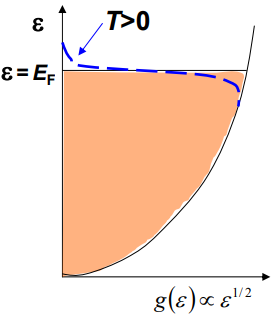


At room temperature, this Fermi gas is strongly degenerate (EF>>kBT).
The total energy of all electrons in the conduction band (per unit volume):

- a very appreciable zero-point energy!
Key takeaway:
A fully degenerate, or zero-temperature, fermion gas is one in which all of the energy levels below a certain value (named Fermi energy) are filled.
Fermi-Dirac statistics apply to fermions, which include electrons, protons, neutrons, and neutrinos.
When the mass of a degenerate gas increases, the particles become closer together due to gravity (and the pressure rises), and the object shrinks.
3.9.1 Density of Energy States
The Fermi function calculates the likelihood of occupying an available energy level, however the number of possible energy states must be multiplied by the number of electrons in the conduction band. This density of states is the same as the electron density of states, but the implications for conductors and semiconductors are different. The density of states for the conductor can be thought of as starting at the bottom of the valence band and filling up to the Fermi level, but because the conduction band and valence band overlap, the Fermi level is in the conduction band, which means there are plenty of electrons available for conduction. The density of states in the semiconductor is the same, but the density of states for conduction electrons starts at the top of the gap.

3.9.2 Introduction
In a semiconductor, the density of electrons is proportional to the density of possible states and the likelihood that each of these states is occupied. The product of the density of states and the Fermi-Dirac probability function (also known as the Fermi function) yields the density of occupied states per unit volume and energy:
n(E) = gC (E) f(E) (f46)
Because holes in the valence band correspond to empty states, the likelihood of having a hole equals the likelihood that a specific state is not filled, resulting in a hole density per unit energy of:
p(E) = gv (E) [ 1 – f(E) ] (f47)
The density of carriers is then calculated by multiplying the density of carriers per unit energy by the number of possible energies within a band. The general formulation and an approximate analytic solution for non-degenerate semiconductors are both derived. In addition, the Joyce-Dixon approximation is shown.
3.9.3 3-D Density of states
Solving the Schrödinger equation for the particles in the semiconductor yields the density of states in the semiconductor. Rather than using the actual and complex potential in the semiconductor, the simple particle-in-a-box model is usually used, in which the particle is assumed to be free to move within the material. For this and other more sophisticated models, the boundary conditions, which describe the fact that particles cannot leave the material, cause the density of states in k-space to stay constant. If the E-k relation is known, the density of states corresponding to it can be found. For a comprehensive derivation in one, two, and three dimensions, the reader should refer to the section on density of states.
The density of states in three dimensions for an electron that behaves as a free particle with effective mass, m*, is given by:
 (f24a)
(f24a)
Ec is the conduction band's lowest point, below which the density of states is zero. For holes in the valence band, the density of states is given by:
 (f24b)
(f24b)
3.9.4 The Fermi function
The Fermi-Dirac probability density function calculates the likelihood of a fermion in thermal equilibrium with a large reservoir occupying a certain energy level. Fermions are particles that have a half-integer spin (1/2, 3/2, 5/2, etc.). The Pauli exclusion principle asserts that only one fermion can occupy a state specified by its set of quantum numbers n,k,l, and s. This is a unique property of fermions. As a result, particles that obey the Pauli exclusion principle could likewise be classified as fermions. All of these particles have a half-integer spin as well.
Both electrons and holes have a spin of 1/2 and follow Pauli's exclusion principle. These particles will fill the available states in an energy band when they are added to it, just like water fills a bucket. The lowest-energy states are filled first, followed by the next higher-energy levels. The energy levels are all filled up to a maximum energy, which we call the Fermi level, at absolute zero temperature (T = 0 K). There are no states filled above the Fermi level. The transition between entirely filled and completely empty states is gradual rather than sudden at higher temperatures. This behaviour is described by the Fermi function, which is:
 (f18)
(f18)
In the graph below, this function is plotted at ambient temperatures of 150 K (red curve), 300 K (blue curve), and 600 K. (black curve).
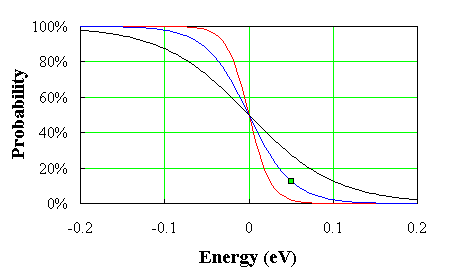
Fig 19. T = 150 K (red curve), 300 K (blue curve), and 600 K Fermi-Dirac distribution function (black curve).
For energies more than a few times kT below the Fermi energy, the Fermi function has a value of one, equals 1/2 if the energy equals the Fermi energy, and declines exponentially for energies a few times kT bigger than the Fermi energy. While the Fermi function equals a step function at T = 0 K, the transition at finite temperatures and higher temperatures is more gradual.
The section on distribution functions has a more extensive description of the Fermi function and other distribution functions.
3.9.5 General expression
Integrating the product of the density of states with the probability density function over all possible states yields the general equation for carrier density in a semiconductor. The integral is calculated for electrons in the conduction band from the bottom of the conduction band, labelled Ec, to the top of the conduction band, as shown in the equation below:
top of the conduction band top of the conduction band
 (f48)
(f48)
The density of states in the conduction band is Nc(E), and the Fermi function is f(E).
The graphic below shows this general equation for a parabolic density of states function with Ec = 0. The density of states function (green curve), the Fermi function (blue curve), and their product, which is the density of electrons per unit volume and per unit energy, n(E), are shown in the figure (red curve). Under the red curve, the integral corresponds to the crosshatched area.
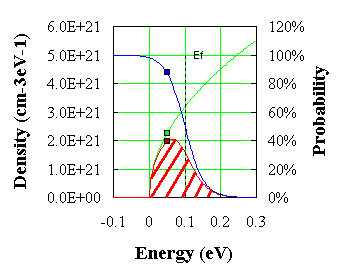
Fig 20. The integral of carrier density. The density per unit energy, n(E), and the probability of occupancy, f(E), are shown (blue curve). The cross-hatched area under the red curve equals the carrier density.
Because the Fermi function approaches 0 at energies greater than a few kT above the fermi energy EF, the actual top of the conduction band does not need to be known, therefore the upper limit can be infinity without changing the integral, yielding:
 (f53)
(f53)
For a three-dimensional semiconductor this integral becomes:
 (f54)
(f54)
While we can't solve this integral analytically, we can get a numeric answer or an approximate analytical answer. In the same way, one obtains holes:
 (f56)
(f56)
And
 (f57)
(f57)
These equations were used to obtain the figure 2.5.2.
3.9.6 Approximate expressions for non-degenerate semiconductors
Non-degenerate semiconductors are those in which the Fermi energy is at least 3 kT distant from either band edge. We limit ourselves to non-degenerate semiconductors since this definition allows us to replace the Fermi function with a simple exponential function. After that, the carrier density integral can be calculated analytically to give:

(f55)
With
 (f5)
(f5)
Where Nc is the effective density of states in the conduction band. Similarly for holes one can approximate the hole density integral as:
 (f58)
(f58)
With
 (f6)
(f6)
Where Nv is the effective density of states in the valence band.
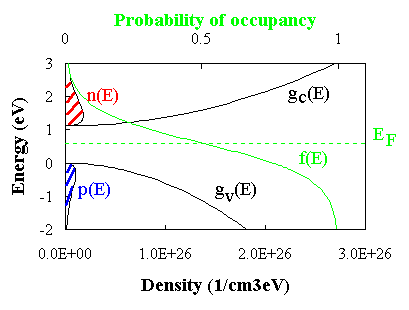
Fig 21. The density of states and carrier densities in the conduction and valence band. Shown are the electron and hole density per unit energy, n(E) and p(E), the density of states in the conduction and valence band, gc(E) and gc(E) and the probability of occupancy, f(E), (green curve). The electron (hole) density equals the red (blue) cross-hatched area
3.9.7 Approximate expressions for degenerate semiconductors
Joyce and Dixon discovered a useful approximate expression for relating the carrier density to the Fermi energy of degenerate semiconductors, which is:
 (f51)
(f51)
For electrons and by:
 (f52)
(f52)
Key takeaway:
The number of solutions to Schrödinger's equation equals the density per unit volume and energy of the number of states in a semiconductor.
The well's energy has been set to zero. The density of states is represented by a function g(E), this time a function of energy, with the relation g(E)dE = the number of states per unit volume in the energy range: (E,E+dE). We start by looking at our system as a free electron gas restricted to points k on the surface.
References:
1. Statistical Mechanics, B.K.Agarwal and Melvin Eisner (New Age Inter-national)-2013
2. Thermodynamics, Kinetic Theory and Statistical Thermodynamics: Francis W.Sears and Gerhard L. Salinger (Narosa) 1998
3. Statistical Mechanics: R.K.Pathria and Paul D. Beale (Academic Press)- 2011
Unit - 3
Quantum Statistics
3.1.1 Imagine two particles on a collision course:
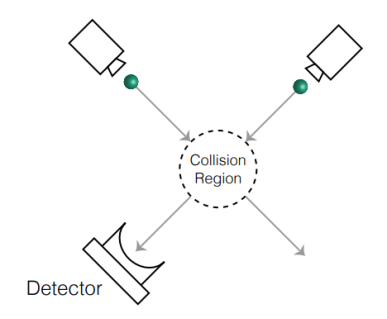
We'd have no issue recognising the path of each ball before, after, and during impact if two particles were bowling balls. If the balls were different colours or masses, it would be evident. Even if the balls were identical in every aspect, we could still track their individual trajectories if we knew their position and velocity at the same time.
But what if the collision occurred between two electrons?
Electrons are identical in every way.
We can't trace their exact paths, according to the uncertainty principle.
We'd never be able to tell which electron enters the detector following a collision.
Because each e wave function has a finite extent, there are overlapping wave functions around the collision zone, and we can't tell which wave function corresponds to which e.
3.1.2 When particles are indistinguishable
QM treatment of 2 e− system must account for indistinguishability. Writing Hamiltonian for 2 electrons requires us to use labels,

In order to maintain indistinguishability, The Hamiltonian must be particle exchange invariant.

If this weren't the case, we'd anticipate detectable changes, which would violate the uncertainty principle.
We must get the same energy with particle exchange:

Define x⃗ = (r, 𝜃, 𝜙, 𝜔) with 𝜔 defined as spin coordinate which can only have values of 𝛼 or 𝛽, that is,  or
or  , respectively.
, respectively.
3.1.3 When particles are indistinguishable
 doesn’t imply that
doesn’t imply that  equal to
equal to  .
.
 is probability density for particle 1 to be at
is probability density for particle 1 to be at  when particle 2 is at
when particle 2 is at  .
. is probability density for particle 1 to be at
is probability density for particle 1 to be at  when particle 2 is at
when particle 2 is at  .
.- These two probabilities are not necessarily the same.
But we require that probability density not depend on how we label particles.
Since  it must hold that
it must hold that

And likewise, that

Both Ψ( ,
, ) and Ψ(
) and Ψ( ) share same energy eigenvalue, E, so any linear combination of Ψ(
) share same energy eigenvalue, E, so any linear combination of Ψ( ,
, ) and Ψ(
) and Ψ( ) will be eigenstate of
) will be eigenstate of  .
.
3.1.4 Particle Exchange Operator
Particle exchange will be carried out by a new operator.

Obviously,  and
and  is not eigenstate of
is not eigenstate of  .
.
Calculating [ ,
, (1, 2)]:
(1, 2)]:
[ ,
, (1, 2)]
(1, 2)]  =
=  (1, 2)
(1, 2) -
-  (1, 2)
(1, 2) 
 (1, 2)
(1, 2)  =
= 
= 0,
Since [ ,
, (1, 2)] =[
(1, 2)] =[ ,
, (2, 1)] =0 eigenstates of
(2, 1)] =0 eigenstates of  and
and  are the same.
are the same.
But  and
and  are not eigenstates of
are not eigenstates of  .
.
Eigenstates of  are some linear combinations of
are some linear combinations of  and
and  that preserve indistinguishability.
that preserve indistinguishability.
3.1.5 Symmetric and Anti-Symmetric Wave functions
We can examine the eigenvalues of 

Since  then
then  but also
but also 
Thus 𝜆2 = 1 and find 2 eigenvalues of  to be 𝜆 = ±1. We can obtain these 2 eigenvalues with 2 possible linear combinations.
to be 𝜆 = ±1. We can obtain these 2 eigenvalues with 2 possible linear combinations.

And

Easy to check that  and
and 
When particles are exchanged, the anti-symmetric wave function changes sign.
No, because when calculating probability or any observable, sign change cancels out.

3.1.6 Symmetric and Anti-Symmetric Wave functions
If you repeat the technique for three identical particles, you will discover

Or

In addition, wave functions for numerous indistinguishable particles must be symmetric or anti-symmetric in terms of particle exchange.
In terms of mathematics, the Schrödinger equation prevents symmetric wave functions from evolving into anti-symmetric wave functions and vice versa.
Under exchange, particles can never modify their symmetric or anti-symmetric behaviour.
3.1.7 Fermions or Bosons
With regards to particle exchange, particles with half-integer spins s = 1/2, 3/2, 5/2,... Are invariably observed to have anti-symmetric wave functions. Fermions are the name given to these particles.
With regards to particle exchange, particles with integer spins s = 0, 1, 2,... Always have symmetric wave functions. Bosons are the name given to these particles.
You'll learn how this rule is derived when you come to relativistic quantum field theory.
For the time being, we will accept this as a quantum mechanics postulate.
3.1.8 Composite Particles
What about a nucleus made up of protons and neutrons, or an atom made up of protons, neutrons, and electrons?
A boson is always a composite particle made up of an even number of fermions and any number of bosons.
A fermion is always an odd number of fermions and any number of bosons.
Identical hydrogen atoms are hence bosons. Note that all hydrogens must be in the same eigenstate to be really similar (or same superposition of eigenstates). In actuality, if you want them to be identical, you'll need extremely low temperatures to get them all in the ground condition.
To use statistics to describe an isolated physical system, we must first make the following assumption:
A microstate, for example, defines the position and momentum of each particle in a classical system of point particles. It determines the value of the wavefunction at every point in space in a quantum mechanical system. You must give the most thorough description you will ever care about to define what microstate the system is in.
You might be thinking if this is a reasonable assumption. What if there aren't any discrete microstates? A classical particle's position and momentum, for example, are continuous rather than discrete. At its most fundamental level, the question of whether the cosmos is discrete or continuous remains unanswered. Fortunately, this turns out not to matter very much. You can always turn a continuous variable into a discrete one by dividing it into very small bins. For the classical particle, we treat all positions between xx and x+δx and all momenta between pp and p+δp as a single microstate.
As long as we choose δx and δp sufficiently small, the exact values turn out to have no effect on most of our results.
This is depicted in Figure 2-1, which depicts the space of possible microstates in one dimension for a single particle. The values of x and p define each microstate. This is known as phase space, and we'll be using it a lot. A 2dN dimensional phase space exists for a system of N particles in dd dimensions. In this phase space, each point (or rather, each tiny volume as depicted in Figure) represents a microstate.

Figure shows the one-dimensional phase space of a single particle. Each axis is segmented into very small intervals. A microstate is a volume defined by the intersection of one interval from each axis.
The number of microstates in ordinary systems is enormous, and they characterise the system in far more detail than humans generally care about. Consider the case of a gas-filled box. You have no means of knowing the exact position and momentum of every single gas molecule, and even if you could, you wouldn't care. Instead, you're usually just concerned with a few macroscopic variables: the system's total energy, the total number of gas molecules, the volume of space it occupies, and so on. These are things that can be measured and are useful in the real world.
The value of each macroscopic variable is used to define a macrostate. It's possible that a large number of microstates belong to the same macrostate. Let's say you want to calculate the total energy and volume of a box of gas. There are a huge variety of different configurations of individual gas molecules that sum up to that amount of energy and volume. You're quite sure the gas is in one of those states, but you're not sure which one.
Key takeaway:
The ratio of the number of microstates in a macrostate to the total number of possible microstates determines the likelihood of discovering it. W (n)/ W (all) = 3/8, for example, is the likelihood of receiving two heads.
Entropy is a measure of a system's randomness (or disorder). It can also be viewed as a measurement of the energy dispersion of the molecules in the system. At a given thermodynamic state, microstates are the number of various potential configurations of molecule position and kinetic energy.
3.3.1 Fermions
Any particle with an odd half-integer spin (such as 1/2, 3/2, and so on) is called a fermion. Fermions include quarks and leptons, as well as most composite particles like protons and neutrons.
The odd half-integer spin has the unintended consequence of obeying the Pauli Exclusion Principle, which means fermions cannot exist in the same state at the same time for reasons we don't fully comprehend.
3.3.2 Bosons
The particles with an integer spin are known as bosons (0, 1, 2...).
All force carrier particles, as well as composite particles containing an even number of fermion particles, are bosons (like mesons).

Depending on whether the total number of protons and neutrons in an atom is odd or even, the nucleus is a fermion or a boson. Physicists recently discovered that this has resulted in some odd behaviour in particular atoms under extraordinary settings, such as extremely cold helium.
3.3.3 Difference Between a Fermion and A Boson.
In the entire Universe, there are only two types of fundamental particles: fermions and bosons. Every particle possesses an intrinsic quantity of angular momentum, often known as spin, in addition to the usual attributes such as mass and electric charge. Fermions are particles with spins in half-integer multiples (e.g., 1/2, 3/2, 5/2, etc.) while bosons are particles with spins in integer multiples (e.g., 0, 1, 2, etc.). In the entire known Universe, there are no other forms of particles, basic or composite. But why is this significant? The following is a question from an anonymous reader:
At first look, it may appear that classifying particles based on these characteristics is utterly arbitrary.
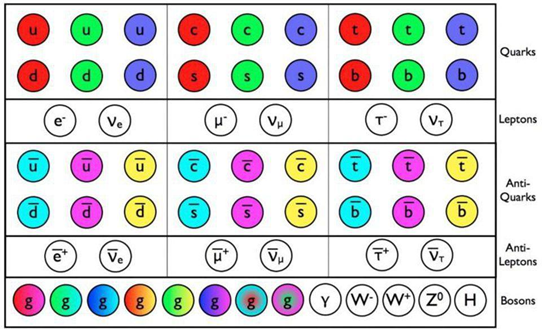
As it turns out, there are a number of little changes in spin that matter, but there are two major ones that impact far more than most people, including physicists, understand.

BROOKHAVEN NATIONAL LABORATORY
The first is that fermions are the only particles that have antiparticle counterparts. It's an antiquark if you're wondering what a quark's antiparticle is. The positron (an anti-electron) is the antiparticle of an electron, and a neutrino has an antineutrino. Bosons, on the other hand, are antiparticles of other bosons, and many bosons are their own antiparticle. No such thing as an antiboson exists. What happens if a photon collides with another photon? Is it possible to have a Z0 with another Z0? From a matter-antimatter standpoint, it's just as good as an electron-positron annihilation.
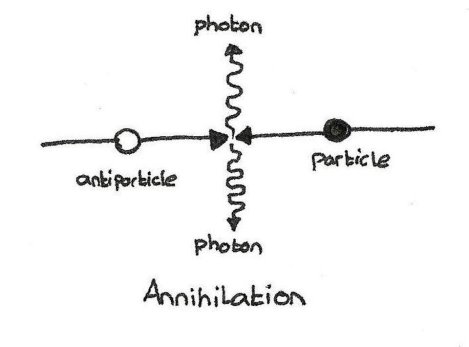
A boson can be its own antiparticle, just like a photon, but fermions.
ANDREW DENISZCZYC, 2017
Composite particles out of fermions: a proton (which is a fermion) is made up of two up quarks and one down quark, whereas a neutron is made up of one up and two down quarks (also a fermion). Because of how spins function, an odd number of fermions together, your new (composite) particle will behave like a fermion, which is why protons and antiprotons exist, and why a neutron differs from an antineutron. However, particles made up of an even number of fermions, such as a quark-antiquark pair (known as a meson), act like a boson. The neutral pion (π0), for instance, is its own antiparticle.
The reason behind this is simple: each of those fermions is a spin ±1/2 particle. If you add two of them together, you can get something that's spin -1, 0, or +1, which is an integer (and hence a boson); if you add three, you can get -3/2, -1/2, +1/2, or +3/2, As a result, it's a fermion. As a result, particle/antiparticle differences are significant. However, there is a second distinction that is arguably much more significant.

Fig 1. The electron energy levels of a neutral oxygen atom in the lowest feasible energy configuration.
CK-12 FOUNDATION AND ADRIGNOLA OF WIKIMEDIA COMMONS
Only fermions, not bosons, are excluded under the Pauli exclusion principle. This rule expressly asserts that no two fermions can occupy the same quantum state in any quantum system. Bosons, on the other hand, are unrestricted. When you add electrons to an atomic nucleus, the first electron will tend to inhabit the ground state, which is the lowest energy state possible. The spin state of that electron can be either +1/2 or -1/2 because it's a spin=1/2 particle. They can no longer fit in the ground state and must progress to the next energy level.
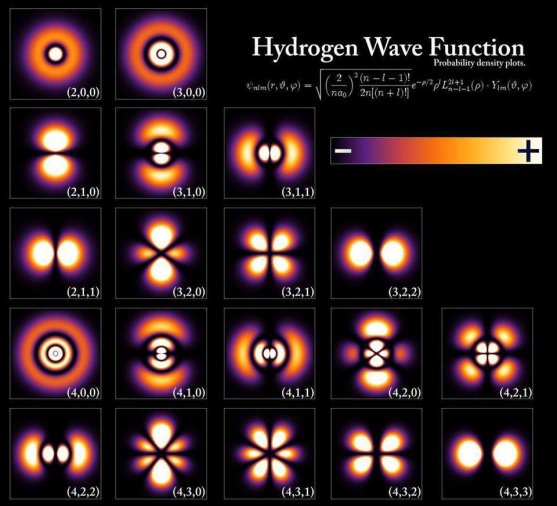
Fig 2. Within a hydrogen atom, the energy levels and electron wavefunctions that correspond to different states.
POORLENO OF WIKIMEDIA COMMONS
That is why the periodic table is set up the way it is. This is why atoms have diverse properties, why they bond together in such complex ways, and why each element in the periodic table is distinct: each type of atom has a different electron configuration than the others. The physical and chemical properties of the elements, the vast variety of molecular configurations we have today, and the basic bonds that allow complex chemistry and life to exist are all due to the fact that no two fermions can occupy the same quantum state.

The way atoms join together to form compounds, such as organic compounds and biological activities.
JENNY MOTTAR
On the other side, you can put as many bosons in the same quantum state as you want! This enables the production of Bose-Einstein condensates, which are extremely rare bosonic states. You can put any number in there by cooling bosons sufficiently such that they fall into the lowest energy quantum state. At low enough temperatures, helium (which is made up of an even number of fermions and hence acts like a boson) becomes a superfluid as a result of Bose-Einstein condensation. Gases, molecules, quasi-particles, and even photons have all been condensed since that time.
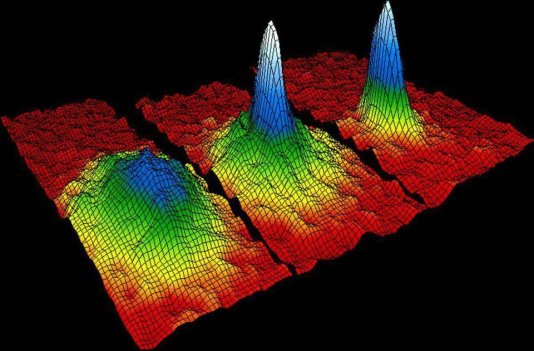
Fig 3. Before (L), during (Middle), and after (R) the... [+] A Bose-Einstein condensate of rubidium atoms before (L), during (Middle), and after (R).
NIST/JILA/CU-BOULDER
White dwarf stars are kept from collapsing under their own gravity by the fact that electrons are fermions; neutron stars are kept from collapsing further by the fact that neutrons are fermions. The Pauli exclusion principle, which governs atomic structure, prevents the densest physical things from turning into black holes.

Fig 4. Fermions make up a white dwarf, a neutron star, and even a bizarre quark star.
CXC/M. WEISS
When matter and antimatter annihilate or decay, the quantity of heat released varies depending on whether the particles follow Fermi-Dirac (for fermions) or Bose-Einstein (for bosons) statistics (for bosons). Because of annihilation and these statistics in the early Universe, the cosmic microwave background temperature is 2.73 K today, whereas the cosmic neutrino background temperature is around 0.8 K lower.
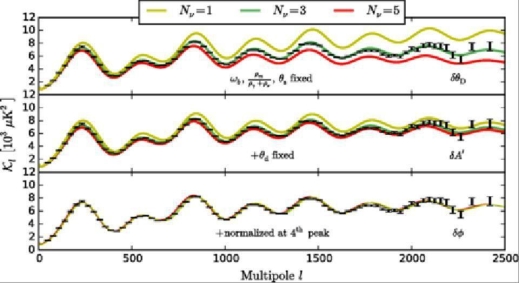
Fig 5. The number of neutrino species that must be present to match the CMB fluctuation data.
BRENT FOLLIN, LLOYD KNOX, MARIUS MILLEA, AND ZHEN PANPHYS. REV. LETT. 115, 091301
The fact that fermions have half-integer spin and bosons have integer spin is intriguing, but the fact that these two classes of particles follow different quantum laws is even more intriguing. Those disparities allow us to exist on a fundamental level. For a difference of only 1/2 in a number as commonplace as intrinsic angular momentum, that's not a bad day at the job. However, the far-reaching repercussions of a seemingly quantum rule demonstrate how important spin.
3.4.1 Introduction
The probability density functions, also known as distribution functions, represent the likelihood that particles would occupy the available energy levels in a particular system. While the actual derivation belongs in a statistical thermodynamics course, understanding the underlying assumptions of such derivations, and hence the applicability of the results, is of importance.
The derivation begins with the premise that each potential particle distribution over the available energy levels has the same probability as any other potential distribution that can be separated from the first.
Furthermore, one considers the fact that both the total number of particles and the total energy of the system have a particular value.
Third, one must recognise that various particles behave differently. At any given energy level, only one Fermion can exist (as described by a unique set of quantum numbers including spin). There is no limit to the number of bosons that can occupy the same energy levels. Fermions and bosons have the same "appearance," that is, they are indistinguishable. It is possible to differentiate Maxwellian particles from one another.
Using the Lagrange method of indeterminate constants, the derivation then produces the most likely particle distribution. One of the Lagrange constants, the average energy per particle in the distribution, turns out to be a more important physical quantity than the total energy. The Fermi energy, or EF, is the name for this variable.
The fact that one is dealing with a high number of particles is an important assumption in the derivation. This assumption allows the Stirling approximation to be used to approximate the factorial terms.
The resulting distributions have several unusual properties that are difficult to explain. First and foremost, regardless of whether a specific energy level exists or not, a probability of occupancy can be calculated. Since the density of possible states defines where particles can be in the first place, it seems more reasonable that the distribution function is dependent on it.
The assumption that a given energy level is in thermal equilibrium with a large number of other particles causes the distribution function to be independent of the density of states. It is unnecessary to go into detail on the nature of these particles because their number is so large. The density of states' independence is advantageous since it gives a single distribution function for a wide range of systems.
The image below shows a plot of the three distribution functions, the Fermi-Dirac distribution, the Maxwell-Boltzmann distribution, and the Bose-Einstein distribution, with the Fermi energy set to zero.
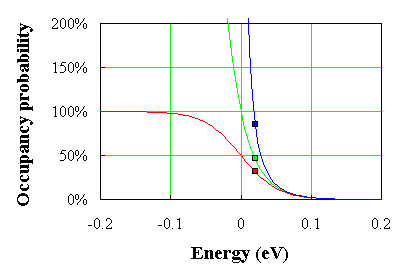
Fig 6. The Fermi-Dirac (red curve), Bose-Einstein (green curve), and Maxwell-Boltzman (blue curve) distributions show occupancy probability versus energy.
For large energies, the three distribution functions are nearly equivalent (more than a few kT beyond the Fermi energy). For energies a few kT below the Fermi energy, the Fermi-Dirac distribution reaches a maximum of 1, whereas the Bose-Einstein distribution diverges at the Fermi energy and has no validity for energies below the Fermi energy.
An example
We now assume a system with equidistant energy levels of 0.5, 1.5, 2.5, 3.5, 4.5, 5.5 eV, each of which can contain two electrons, to better comprehend the general derivation without going through it. Because the electrons are Fermions, they are indistinguishable from one another, and only two electrons (with opposite spin) can occupy the same energy level. This system has 20 electrons, and we set the total energy to 106 eV, which is 6 eV higher than the system's minimum possible energy. There are 24 different and viable setups that satisfy these restrictions. Six of these arrangements are depicted in the diagram below, with the electrons represented by red dots:
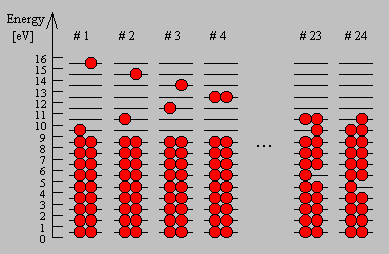
Fig 7. Six of the 24 conceivable configurations with an energy of 106 eV in which 20 electrons can be inserted.
A complete list of the 24 configurations is shown in the table below:

Table: All 24 conceivable configurations with a total energy of 106 eV in which 20 electrons can be placed.
The average occupancy of each energy level over all (and equally likely) 24 configurations is compared to the expected Fermi-Dirac distribution function in the figure below. With a Fermi energy of 9.998 eV and kT = 1.447 eV or T = 16,800 K, the best fit was found. Considering the system's tiny size, the agreement is quite good.
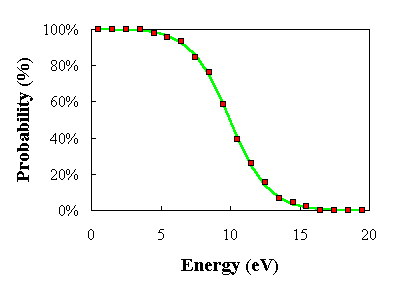
Fig 8. Probability versus energy averaged over the 24 possible configurations of the example (red squares) fitted with a Fermi-Dirac function (green curve) using kT = 1.447 eV and EF= 9.998 eV.
3.4.2 The Fermi-Dirac distribution function
The Fermi-Dirac probability density function calculates the likelihood of a Fermion in thermal equilibrium with a large reservoir occupying a certain energy level. Fermions are particles that have a half-integer spin (1/2, 3/2, 5/2, etc.). The Pauli exclusion principle asserts that only one Fermion can occupy a state specified by its set of quantum numbers n,k,l, and s. This is a unique property of Fermions. As a result, Fermions could alternatively be defined as particles that follow the Pauli exclusion principle. All of these particles have a half-integer spin as well.
Both electrons and holes have a spin of 1/2 and follow Pauli's exclusion principle. These particles will fill the available states in an energy band when they are added to it, just like water fills a bucket. The lowest-energy states are filled first, followed by the next higher-energy levels. The energy levels are all filled up to a maximum energy, which we call the Fermi level, at absolute zero temperature (T = 0 K). There are no states filled above the Fermi level. The transition between entirely filled and completely empty states is gradual rather than sudden at higher temperatures. This behaviour is described by the Fermi function, which is:
 (f18)
(f18)
This function is plotted in the figure below.
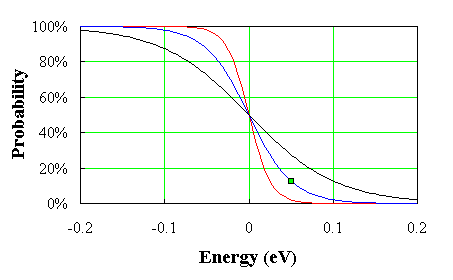
Fig 9. The Fermi function at 150 K (red curve), 300 K (blue curve), and 600 K (green curve) (black curve).
For energies that are greater than a few times kT below the Fermi energy, the Fermi function has a value of one. If the energy is equal to the Fermi energy, it equals 1/2, and it drops exponentially for energies a few times kT more than the Fermi energy. While the Fermi function equals a step function at T = 0 K, the transition at finite temperatures and higher temperatures is more gradual.
3.4.3 The Bose-Einstein distribution function

For particles that follow Bose-Einstein statistics, we let the probability of a microstate of energy E in an N-particle system be  . For an isolated system of Bose-Einstein particles, the total probability sum is
. For an isolated system of Bose-Einstein particles, the total probability sum is

We need to find  , the number of ways to assign indistinguishable particles to the quantum states, if any number of particles can occupy the same quantum state.
, the number of ways to assign indistinguishable particles to the quantum states, if any number of particles can occupy the same quantum state.
The number of ways that Ni particles can be allocated to the gi quantum states associated with the energy level I is first considered. We can see that the smallest number of quantum states that can be employed is one; all of the particles can be placed in one quantum state. On the other hand, when each particle has its own quantum state, we can't use more than the Ni quantum states. This task can be viewed as determining the amount of ways we can draw as many gi boxes around Ni spots as possible. Let's make a plan for sketching these boxes. Assume we have a linear frame with a row of spots on it. One particle can be stored in each position. Both ends of the frame are closed. There is a slot between each pair of particle-holding positions, into which a wall can be put. Figure 1 shows a rough sketch of this frame.

Figure 10. Scheme for assigning degenerate energy levels to Bose-Einstein particles.
The frame comprises gi boxes when we place (gi1) walls into these slots. We want to be able to place the walls so that the Ni particles are spread evenly among the gi boxes, allowing us to put any number of particles in any number of boxes. (Of course, the wall placement is constrained by the requirements that we employ at most gi boxes and exactly Ni particles.) This can be accomplished by building the frame with (Ni+gi1) particle-holding sites. Consider the case in which the highest number of particle-holding sites is required. This is the scenario when all Ni particles are contained in a single box.
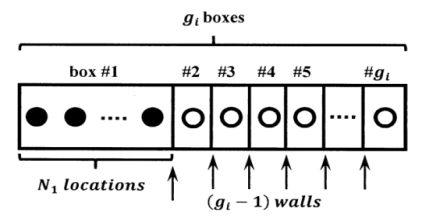
Figure 11. Ni particles in gi positions have a maximum size frame.
Now we'll look at how many different ways we can fit (gi1) walls into the (Ni+gi1) slots. The initial wall can be placed in any of the slots (Ni+gi1). The second can be used in either the (Ni+gi1(1)) or (Ni+gi2) slots. The last wall can be placed in either the (Ni+gi1(gi2)) or (Ni+1) slots. As a result, the total number of ways to place the (gi1) walls is

Because it contains all permutations of the walls, this total is bigger than the answer we seek. It makes no difference whether a slot is occupied by the first, second, or third wall. As a result, by the factor (gi1)!, which is the number of ways to permute the (gi1) walls, the equation we produced over-counts the quantity we want. As a result, the Ni particles can be allocated to gi quantum states in quantum mechanics.

Ways, and hence

So that the total probability sum for a Bose-Einstein system becomes (via Equation 25.3.1):

To find the Bose-Einstein distribution function, we seek the population set {N1, N2,…, Ni,…} for which WBE is a maximum, subject to the constraints

And

The mnemonic function is

We seek the N⦁i⦁ for which FBEmn is an extremum; that is, the N⦁i⦁ satisfying



Solving for N⦁i⦁, we find

Where the last expression takes advantage of the fact that gi is usually a very large number, so the error introduced by replacing (gi−1) by gi is usually negligible. If 1 ≫  , the Bose-Einstein distribution function reduces to the Boltzmann distribution function.
, the Bose-Einstein distribution function reduces to the Boltzmann distribution function.
Key takeaway:
Fermi–Dirac statistics are used to describe fermions (particles that follow the Pauli exclusion principle), while Bose–Einstein statistics are used to describe bosons. At high temperatures or low concentrations, both Fermi–Dirac and Bose–Einstein statistics become Maxwell–Boltzmann statistics.
The Fermi-Dirac distribution function, often known as the Fermi function, calculates the likelihood of Fermions occupying energy levels. Fermions are half-integer spin particles that follow Pauli's principle of exclusion.
The exotic quantum phenomena of Bose-Einstein condensation was first detected in dilute atomic gases in 1995, and it is currently the focus of extensive theoretical and experimental research.
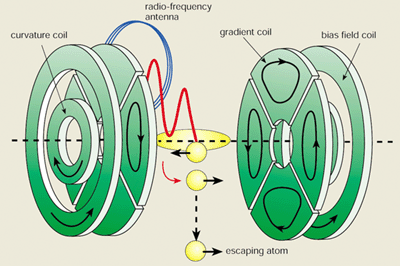
Figure 12. The cloverleaf magnetic trap at MIT is set up for evaporative cooling.
Axial confinement is provided by the middle (curvature) coils, while radial confinement is provided by the outside coils (the "clover leaves" or gradient coils). Cigar-shaped clouds are formed as a result of the anisotropic potential. The most energetic atoms' spins are preferentially flipped by radio-frequency radiation from an antenna, while the remainder atoms rethermalize to a lower temperature. The radio-frequency is lowered to force cooling.
Satyendra Nath Bose, an Indian physicist, wrote Einstein a paper in 1924 in which he calculated the Planck rule for black-body radiation by treating photons as a vapour of identical particles. In the same year, Einstein extended Bose's theory to an ideal gas of identical atoms or molecules, in which the number of particles is conserved, and predicted that the particles would get trapped together in the system's lowest quantum state at sufficiently low temperatures. We now know that Bose-Einstein condensation (BEC) occurs only for “bosons” — particles having a total spin that is an integer multiple of h, the Planck constant divided by 2 pi.
This Bose condensate, as well as the condensation process itself, was predicted to exhibit a variety of odd features, and scientists have been attempting to create Bose-Einstein condensation in the laboratory for years. Finally, in 1995, researchers from the Massachusetts Institute of Technology (MIT) and JILA, a laboratory maintained by the National Institute of Standards and Technology and the University of Colorado in Boulder, Colorado, uncovered convincing evidence for Bose-Einstein condensation in dilute atomic gases.
Since then, the Boulder and MIT teams, as well as a team at Rice University in Houston, Texas, have refined the procedures for making and studying this unique quantum phenomena, and rapid progress has been made in understanding its dynamic and thermodynamic features. At MIT, we recently confirmed the fascinating property of Bose-condensed atoms being "laser-like" — that is, that the atoms' matter waves are coherent. We were able to observe coherence directly in these experiments, and we developed a crude "atom laser" that generates a beam of coherent atoms, similar to how an optical laser emits coherent photons. Simultaneously, theorists have addressed a number of fundamental difficulties and devised effective ways for simulating real-world systems.
3.5.1 Order reigns in the ground state
The dynamical behaviour of a gas at room temperature is not affected by the fact that one atom cannot be distinguished from another. In accordance with the Heisenberg uncertainty principle, the position of an atom is smeared out over a distance given by the thermal de Broglie wavelength, λdB = (2 pi h-bar2 / kBmT)1/2, where kB is the Boltzmann constant, m is the atomic mass and T is the temperature of the gas. At room temperature the de Broglie wavelength is typically about ten thousand times smaller than the average spacing between the atoms. This means that the matter waves of the individual atoms are uncorrelated or “disordered”, and the gas can thus be described by classical Boltzmann statistics.
As the gas is cooled, however, the smearing increases, and eventually there is more than one atom in each cube of dimension λdB. The wavefunctions of adjacent atoms then “overlap”, causing the atoms to lose their identity, and the behaviour of the gas is now governed by quantum statistics.
Bose-Einstein statistics dramatically increase the chances of finding more than one atom in the same state, and we can think of the matter waves in a Bose gas as “oscillating in concert”. The result is Bose-Einstein condensation, a macroscopic occupation of the ground state of the gas. (In contrast, fermions – particles with a total spin of (n + ½)h, where n is an integer – cannot occupy the same quantum state.) Einstein described the process as condensation without interactions, making it an important paradigm of quantum statistical mechanics.
The density distribution of the condensate is represented by a single macroscopic wavefunction with a well-defined amplitude and phase, just as for a classical field. Indeed, the transition from disordered to coherent matter waves can be compared to the change from incoherent to laser light.
3.5.2 Chilling the atoms
Bose-Einstein condensation has been cited as an important phenomenon in many areas of physics, but until recently the only evidence for condensation came from studies of superfluid liquid helium and excitons in semiconductors. In the case of liquid helium, however, the strong interactions that exist in a liquid qualitatively alter the nature of the transition. For this reason, a long-standing goal in atomic physics has been to achieve BEC in a dilute atomic gas. The challenge was to cool the gases to temperatures around or below one microkelvin, while preventing the atoms from condensing into a solid or a liquid.
Efforts to Bose condense atoms began with hydrogen more than 15 years ago. In these experiments hydrogen atoms are first cooled in a dilution refrigerator, then trapped by a magnetic field and further cooled by evaporation (see below). This approach has come very close to observing BEC, but is limited by the recombination of individual atoms to form molecules and by the detection efficiency.
In the 1980s laser-based techniques such as Doppler cooling, polarization-gradient cooling and magneto-optical trapping were developed to cool and trap atoms. These techniques profoundly changed the nature of atomic physics and provided a new route to ultracold temperatures that does not involve cryogenics. Atoms at sub-millikelvin temperatures are now routinely used in a variety of experiments. Alkali atoms are well suited to laser-based methods because their optical transitions can be excited by available lasers and because they have a favourable internal energy-level structure for cooling to low temperatures.
However, the lowest temperature that these laser cooling techniques can reach is limited by the energy of a single photon. As a result, the “phase-space density” – the number of atoms within a volume lambdadB3 – is typically about a million times lower than is needed for BEC.
The successful route to BEC turned out to be a marriage of the cooling techniques developed for hydrogen and those for the alkalis: an alkali vapour is first laser cooled and then evaporatively cooled. In evaporative cooling, high-energy atoms are allowed to escape from the sample so that the average energy of the remaining atoms is reduced. Elastic collisions redistribute the energy among the atoms such that the velocity distribution reassumes a Maxwell-Boltzmann form, but at a lower temperature. This is the same evaporation process that happens when tea cools, but the extra trick for trapped atoms is that the threshold energy can be gradually lowered. This allows the atomic sample to be cooled by many orders of magnitude, with the only drawback being that the number of trapped atoms is reduced.
The challenge in combining these two cooling schemes for alkalis was a question of atomic density. Optical methods work best at low densities, where the laser light is not completely absorbed by the sample. Evaporation, on the other hand, requires high atomic densities to ensure rapid rethermalization and cooling. This changed the emphasis for optical methods: while they had previously been used to produce low temperatures and high phase-space density simultaneously, they now needed to produce high elastic collision rates. Furthermore, this had to be achieved in an ultrahigh vacuum chamber to prolong the lifetime of the trapped gas. Thus no new concept was needed to achieve BEC, but rather it was an experimental challenge to improve and optimise existing techniques. These developments were pursued mainly at MIT and Boulder from the early 1990s.
3.5.3 Improved techniques in magnetic trapping
For evaporative cooling to work, the atoms must be thermally isolated from their surroundings. This must be done with electromagnetic fields, since at ultracold temperatures atoms stick to all surfaces. The best method for alkalis is magnetic confinement, which takes advantage of the magnetic moment of alkali atoms. After the atoms are trapped and cooled with lasers, all light is extinguished and a potential is built up around the atoms with an inhomogeneous magnetic field. This confines the atoms to a small region of space.
Atoms can only be cooled by evaporation if the time needed for rethermalization is much shorter than the lifetime of an atom in the trap. This requires a trap with tight confinement, since this allows high densities and hence fast rethermalization times. For this reason, the first experiments that observed BEC used so-called linear quadrupole traps, which have the steepest possible magnetic fields.
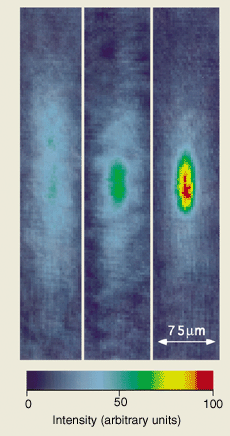
Figure 13: At MIT, dispersive light scattering (phase-contrast imaging) was used to observe the development of a Bose condensate in a direct and non-destructive way.
The intensity of dispersed light is plotted as a function of trap position, which is proportional to the atom column density along the line of sight. The cloud has been cooled to just above the BEC transition temperature in the figure on the left, and the atom distribution is practically classical. A strong peak of atoms appears at the trap centre (middle) as the temperature is decreased across the phase transition, and further cooling increases the condensate fraction to nearly 100%. (right).
These approaches do create great densities and rapid evaporation, but they have one fundamental flaw: the magnetic field at the centre is zero, causing an atom to become "disoriented" and lose its magnetic moment's alignment. These "spin flips" result in a calamitous loss of atoms from the trap since a magnetic field can only confine atoms with magnetic moments that are antiparallel to the field. Both the Boulder and MIT teams devised solutions to the challenge. A rotating magnetic field was created by the Boulder group to keep the atoms away from the "hole," while we "plugged" the hole using the repulsive force of a focused laser beam.
Both of these methods were successful, yet they both had significant flaws. We discovered BEC in an unique "cloverleaf" magnetic trap that overcome these restrictions in March 1996. This trap is a modification of the Ioffe-Pritchard trap, which was first proposed in 1983 and contains a non-zero magnetic field at its centre to prevent atom loss. The confinement is tight in two directions but weak in the third, resulting in cigar-shaped trapped clouds rather than spherical trapped clouds. The trap's unique feature is the coils' "cloverleaf" winding arrangement, which provides good optical access to the sample for laser cooling and trapping, as well as probing the condensate (see figure 1). The trap's design has proven to be dependable and versatile, and it was used to gather the majority of the experimental results shown here. Given the amount of effort that has gone into trap design in recent years, it's remarkable that the best setup has been around for almost 13 years.
Using electron spin resonance, evaporation can be easily accomplished in a magnetic trap. Applying a radio-frequency field in resonance with the energy difference between the spin-up and spin-down states flips the magnetic moments of trapped atoms. The field's frequency is set such that it only impacts the atoms at the cloud's edge, which have the most energy in a harmonic oscillator potential. The magnetic forces become anti-trapping and the atoms are freed from the trap when the moments of these atoms are inverted. Because the cloud cools and shrinks towards the trap's centre, the frequency of the radio-frequency field must be decreased to keep evaporation at the cloud's perimeter.
In our trials, sodium atoms are ejected from an oven at 600 K (800 m s-1) and a density of around 1014 cm-3. The atoms are initially slowed to a speed of roughly 30 m s-1 over a distance of 0.5 m using a laser beam. Around 1010 atoms can be trapped in a magneto-optical trap at this speed. The temperature of the gas is reduced to roughly 100 K using laser cooling and trapping techniques, which is cold enough for the atoms to be trapped with magnetic fields. In about 20 seconds, evaporation cools the gas to about 2 K, the temperature at which a condensate develops.
The density of atoms at condensation is approximately 1014 cm-3, which is similar to that of the atomic beam oven. As a result of the cooling sequence, the temperature is reduced by 8 to 9 orders of magnitude. We normally lose a factor of 1000 atoms during evaporative cooling and generate condensates with 107 atoms. Condensates in the cloverleaf trap can be up to 0.3 mm long. As a result of condensation, we now have macroscopic quantum objects.
3.5.4 Observing condensation
Condensates trapped in the trap are very tiny and optically thick, making them difficult to see. By turning off the trap and letting the atoms to expand ballistically, the first observations of BEC were made. After that, a laser beam in resonance with an atomic transition was flashed on, and the subsequent light absorption generated a "shadow" that was captured by a camera. This picture of atomic locations records the velocity distribution of the atoms since they were released from the trap. Because the atoms in the condensate are in the lowest energy state, they expand very little, and the dramatic mark of Bose condensation was thus the abrupt development of a prominent peak of atoms in the image's centre.
Because the atoms are freed from the trap, absorption imaging is fundamentally destructive. Furthermore, the atoms are heated by the absorbed photons. In early 1996, we used "dark-ground" imaging, a technique that depends on dispersion rather than absorption, to examine a Bose condensate non-destructively.
A complicated index of refraction can be used to characterise both dispersion and absorption. The absorption of photons from the probe beam is described by the imaginary part of the index, which is followed by inelastic scattering of light over high angles. Coherent elastic scattering over small angles corresponds to the real part. The phase of the light is altered by dispersive scattering, and because the light is only slightly deflected, the technique is nearly non-perturbative. The crucial point is that if the probing laser is detuned far enough away from any atomic resonances, dispersive scattering dominates absorption, and the condensate resembles a piece of shaped glass, or a lens.
The phase shift induced by the atoms must be converted into an intensity variation in order to “see” the condensate using dispersive scattering. This is a well-known optical problem that can be solved by spatial filtering. Opaque objects (“dark-ground imaging”) or phase-shifters (“phase-contrast imaging”) are used to alter the signal in the Fourier plane.
Because dispersive imaging is non-destructive, many photographs of the same condensate can be acquired. Figure 2 shows phase-contrast imaging of the development of a condensate. Such real-time pictures will be essential in researching a condensate's dynamical behaviour.
3.5.5 Theory and first experiments
The theoretical study of trapped weakly interacting Bose gases has a long history, dating back to Gross and Pitaevskii's ground breaking work on the macroscopic wavefunction for such systems in the 1950s. The number of papers devoted to the idea of trapped Bose gases has increased dramatically in the last year, indicating the numerous unanswered and intriguing topics that have piqued the scientific community's attention.
The theoretical research can be divided into two categories. On the one hand, the "many-body problem" is solved in the case of many atoms inhabiting the ground state. The goal is to figure out how interatomic forces affect condensate structural features such ground state configuration, dynamics, and thermodynamics. The study of coherence and superfluid effects in these unique systems is the second topic of great interest.
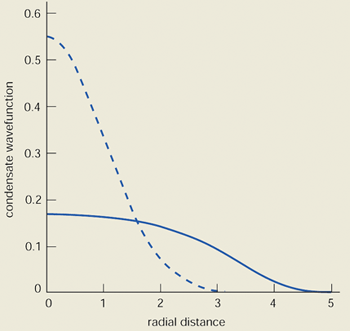
Figure 14: For a cloud of 5000 rubidium atoms, a theoretical computation of the condensate wavefunction versus radial co-ordinate was performed.
The solid line represents the solution of the Gross-Pitaevskii equation, which is the Schrodinger equation with two-body collisions included, while the dashed line is a non-interacting cloud prediction.
The new availability of experimental data has sparked theoretical analyses of structural characteristics. Because collisions only occur between pairs of atoms in a dilute Bose gas, interaction effects are simplified and may be described using a single parameter, the s-wave scattering length (which in most cases is a distance comparable with the range of the interaction). The intricate interactions that exist in liquid helium are in sharp contrast to this setting.
However, a key finding from recent theoretical work is that two-body interatomic forces in condensates can be extremely strong, even when the gas is dilute. The significance of interactions in the Schrödinger equation for the condensate wavefunction is determined by the amount of the interaction energy per atom compared to the harmonic trap's ground-state energy. This ratio is determined by the ratio Na/aHO, where an is the s-wave scattering length, aHO is the oscillation amplitude of a particle in the ground state, and N is the number of atoms. Although a/aHO is normally around 10-3, N can be as high as 107, so interactions can significantly alter the ground-state wavefunction and energy (see figure 3). Experiments at both Boulder and MIT have confirmed the predicted relation of energy on the number of atoms.
The normal modes of oscillation of a Bose condensate can be investigated using the time-dependent Schrödinger equation. These are equivalent to the phonon and roton excitations in super fluids, which have been widely researched. Understanding collective quantum excitations has long been important in describing the features of superfluid liquid helium, and pioneering work by Lev Landau, Nikolai Bogoliubov, and Richard Feynman has contributed to this understanding (see Donnelly in Further reading).

Figure 15: At MIT, shape oscillations of a Bose condensate were observed.
The cloud was then allowed to oscillate freely for a varied time ranging from 16 ms (left) to 48 ms after the trapping potential was disrupted with a time-dependent field (right). By turning off the trap and allowing the atoms to grow ballistically for 40 milliseconds, the clouds were observed.
The equations of motion for a confined Bose gas have a form that Bogoliubov derived in 1947, and these have recently been intensively investigated. The equations take the simple form of the superfluid hydrodynamic equations when the parameter Na/aHO is very big. The frequency, omega, of quantum excitations in an isotropic harmonic-trapping potential is found to follow the dispersion law omega = omega0(2n2 + 2nl + 3n + l)1/2, where omega0 is the trap frequency, n is the number of nodes in the wavefunction along a trap radius, and l is the angular momentum carried by the excitation. For particles that do not interact, this should be compared to omega = omega0(2n + l). The interactions play a crucial role in the "surface" modes (n = 0), where they reduce the excitation energies from omega = omega0l to omega = omega0l1/2.
For anisotropic traps, the hydrodynamic equations can also be solved analytically, providing useful predictions for the experiments at Boulder and MIT. Condensates were gently "shaken" in these studies by changing magnetic trapping fields, causing oscillations in the form of the condensate. For a cigar-shaped cloud, the mode indicated in figure 4 is analogous to a quadrupole oscillation: contraction in the long direction is followed by expansion in the short direction, and vice versa. Experiments at MIT confirmed the theoretical prediction of this mode's frequency to within 1%. Indeed, the most remarkable and persuasive demonstration of the relevance of contacts in condensates has come from measurements of internal energy and the frequency of collective excitations carried out at both Boulder and MIT.
When the temperature approaches the BEC transition temperature, the consequences of two-body interactions become less important. This is because atoms become thermally stimulated and spread out, resulting in a gas that is considerably more dilute than the condensate. The predictions for a non-interacting gas for the transition temperature kBT0 = 0.94h-bar omega0 N1/3 and the "condensate fraction" – the percent of atoms that are condensed – N0/N = 1 -(T/T0)3 are not greatly impacted by interactions, according to early observations at MIT.
Theoretically, interactions should affect both T0 and N0/N, and these effects should be visible using high-precision measurements of both values. A change of N0 compatible with theoretical expectation has been detected at Boulder, but this change is comparable to the measurement uncertainty (figure 5). In general, the thermodynamic behaviour of trapped Bose gases differs from that of uniform (constant density) gases in fascinating ways. Interactions in a uniform gas boost T0, whereas interactions in a confined gas lower it.
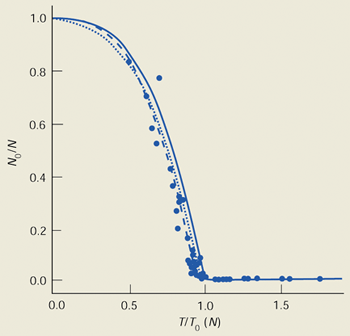
Figure 16: Condensate fraction, N0/N, measured as a function of scaled temperature, T/T0, at Boulder.
T0 is the predicted critical temperature for an ideal gas in a harmonic trap in the thermodynamic limit (many atoms). The solid curve is the predicted dependence in the thermodynamic limit, and the dotted curve includes a correction for the finite number of atoms (4000) in the condensate. To the uncertainties in the data, the measurement is consistent with the theory for non-interacting bosons. The dashed line is a best fit to the experimental data.
Many theoretical questions for trapped Bose gases remain to be explored and understood. Two major issues concerning collective excitations are the treatment of oscillations near to T0 and the mechanisms by which oscillations are damped, particularly at low temperatures. Related questions concern nonlinear effects in excitations, the onset of chaotic phenomena and the variation of excitation frequencies with temperature.
An important problem is the behaviour of trapped gases with negative s-wave scattering lengths. In the experiments at MIT and Boulder the scattering lengths are positive. This means that the effect of the two-body collisions is to cause repulsion between the atoms (“hard-sphere” collisions), and in such an instance it is theoretically well understood that a Bose condensate is stable. For negative scattering lengths, however, the forces between the atoms are attractive and tend to cause a condensate to collapse. This is believed to prevent condensation completely in a uniform system and restrict the number of atoms that can be condensed in an inhomogeneous system such as a trap. Measurements of BEC in lithium have been carried out at Rice University and the number of condensed atoms is consistent with theory.
As mentioned above, the property of superfluidity (i.e. persistent flow without viscous damping) is closely related to the existence of long-range order, or coherence, in the ground state. Indeed, the superfluid velocity is proportional to the gradient of the phase of the ground-state wavefunction. This implies, for example, that the moment of inertia of a Bose gas below T0 differs from that expected for a rigid body. Superfluidity and coherence phenomena will become challenging areas for future research. Theorists have already made quantitative predictions for the Josephson-type effects and interference phenomena associated with the phase of the condensate wavefunction. The role of vortices in the dynamics of the system, the possible occurrence of “second sound”, and the interplay between collective excitations, rotational properties and superfluidity are further problems of fundamental interest.
3.5.6 Realization of a basic atom laser
The possibility of producing a coherent beam of atoms, which could be collimated to travel large distances or brought to a tiny focus like an optical laser, has sparked the imagination of atomic physicists. Such an atom laser could have a major impact on the fields of atom optics, atom lithography and precision measurements.
A Bose-Einstein condensate is a sample of coherent atomic matter and is thus a good starting point for an atom laser. The process of condensing atoms into the ground state of a magnetic trap is analogous to stimulated emission into a single mode of an optical laser and one can think of the trap as a resonator with “magnetic mirrors”. An important feature of a laser is an output coupler to extract a fraction of the coherent field in a controlled way, and at MIT we recently demonstrated such a device for a trapped Bose gas.
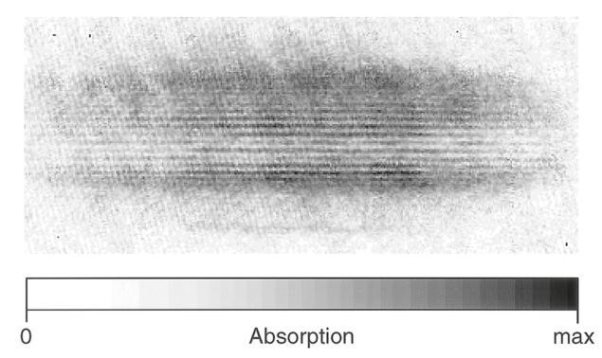
Figure 17: Two overlapping condensates form an interference pattern.
This image depicts raw data and was captured in absorption. The tiny, straight striations have a period of 15 m and are fringes caused by matter-wave interference. The ballistic expansion from a harmonic double-well potential is responsible for the significantly bigger modulations in the cloud structure.
Because a magnetic trap can only confine atoms with magnetic moments that are antiparallel to the magnetic field, we changed the “reflectivity” of the magnetic mirrors by tilting the atoms' magnetic moments using a short radio-frequency pulse. The atoms were removed in this manner, accelerated under gravity, and absorption imaging was used to examine them. The extracted fraction may be changed between 0% and 100% by altering the amplitude of the radio-frequency field (see Physics World 1996 October p18).
The coherence of a laser's output, or the presence of a macroscopic wave, is an important aspect. Coherence has been utilised as a defining condition for BEC in theoretical treatments. However, none of the measurements detailed thus far have shown long-range order. Although collective measurements match with Schrödinger equation solutions at zero temperature, identical frequencies have been anticipated for a classical gas in the hydrodynamic regime.
Examining the impacts of the phase of the condensate wavefunction is one way to explore coherence. The Josephson effect has been used to see this phase in superconductors, and the motion of quantized vortices in liquid helium has been used to infer it. Because phase is a complex number, it can only be recognised as an interference effect between two different wavefunctions, similar to how interference between two independent laser beams may be detected. Theoretical work on coherence and the interference features of confined Bose gases has recently gotten a lot of interest. The theoretical issues that lie beneath are of great interest and concern. For example, can spontaneous symmetry breaking (an important topic in physics) apply in systems with few atoms, and what impact do particle-particle interactions have on the phase of the condensate ("phase diffusion")?
We recently witnessed high-contrast interference of two separate Bose condensates at MIT, demonstrating that a condensate has a well-defined phase. By concentrating a sheet of light into the cloverleaf trap and repelling atoms from the centre, we created a double-well trapping potential. Evaporation resulted in the formation of two distinct condensates. These were left to free-fall and expand ballistically under gravity.
The clouds overlapped horizontally after lowering 1 cm, and absorption revealed the interference pattern (figure 6). The fringes have a period of 15 p.m., which matches the respective de Broglie wavelengths of the overlapping clouds. When the imaging system's resolving power is taken into account, the intensity difference between the light and dark fringes indicate that the atomic interference modulation was between 50% and 100%. Figure 6 has the unique feature of being a real-time snapshot showing interference. The wavefront of a single particle is separated and then recombined in classic experiments to demonstrate the wave aspect of matter, and this is repeated numerous times to build up an interference pattern.
Using the radio-frequency output coupler, high-contrast interference was also detected between two pulses of atoms taken from a double condensate. This is a basic instantiation of an atom laser, demonstrating that a coherent beam of atoms may be extracted from a Bose condensate.
3.5.7 Where do we go next?
Bose-Einstein condensation has given us not only a new type of quantum matter, but also a one-of-a-kind source of ultracold atoms. Evaporative cooling has made nanokelvin temperatures accessible to researchers, and with additional optimization, condensates of 108 atoms could be attainable at durations of 5-10 seconds. This pace of creation is comparable to that of a typical light trap, indicating that Bose condensation could eventually replace the magneto-optical trap as the primary bright source of ultracold atoms for precision investigations and matter-wave interferometry.
To date, the experiments have looked at some of the fundamental features of condensation and found good agreement with theory. The discovery of phase coherence in BEC represents a major step forward in the development of coherent atomic beams. However, there are still a number of fundamental concerns that can only be answered by experiments, particularly in the area of Bose gas dynamics, such as the production of vortices and superfluidity.
Exploration of additional atomic systems is another major direction. Rice's lithium research has paved the way for a better understanding of Bose gases with negative scattering lengths. “Sympathetic cooling” produced two different forms of condensate in the same trap at Boulder recently. In this system, a cloud of rubidium atoms in one energy level was cooled through evaporation as normal, while a second cloud of atoms in a different energy state was cooled through thermal contact with the first cloud. Ultracold temperatures will be accessible to atoms that are not well suited to evaporation, such as fermionic atoms whose elastic scattering rate vanishes at low temperatures or uncommon isotopes that can only be confined in small numbers, as a result of this cooling of one species by another. Fermions do not condense, but cooling them into the quantum statistics domain could reveal new information on Cooper pairing and superconductivity.
It's always interesting when physics subfields collide. Individual atoms or interactions between a few atoms have historically been the focus of atomic physics. With the establishment of BEC in dilute atomic gases, we can now study many-body physics and quantum statistical effects with the precision of atomic physics experiments, and it's thrilling to see how quickly these new quantum gases are being explored.
3.6.1 How to see Planck's radiation law as a consequence of Bose Einstein statistics?
Planck's law is the result of the following factors.
1) The mode density per unit volume in a cavity is 8πυ2/c3.
2) Within each mode, assume Boltzmann statistics i.e the probability of having an energy E is given by p(E) ∝ e-E/kT
3) Ask that the energies E be discretized as nhν instead of continuous. Essentially, the difference between doing  and the sum
and the sum  , where
, where  gives Planck's law.
gives Planck's law.

So far, it's a nice trick to go to the discrete sum but that's all that was done. There is no sense in which the particles are indistinguishable etc.
What is the correct modern way of seeing this result? I assume the starting point is that we have an ideal gas of photons inside a blackbody cavity and they follow statistics that yield  but how exactly does one go from there to Planck's law?
but how exactly does one go from there to Planck's law?
As you mentioned, we use a cavity as a model for blackbody radiation, for which you have already determined the mode density.

The photons' energies are discretized and have the formula E=nhv, where nn is an integer. The grand-canonical partition function for bosons with vanishing chemical potential will now be written down. Because photons interact with the cavity's walls, the number of photons isn't constant, it's taken to be zero. For a given frequency 0 the partition function is The energies that photons can have are discretized and have the formula E=nh, where nn is a positive integer. The grand-canonical partition function for bosons with vanishing chemical potential will now be written down. Because photons interact with the cavity's walls, the number of photons isn't constant, it's taken to be zero. For a given frequency 0 the partition function is

The total partition function can then be obtained by multiplying all of the frequency partition functions together.

Taking the logarithm of ΞΞ will transform the product in a sum

Which can be modified in an integral if the difference in frequency between two consecutive frequencies becomes minuscule. We can delegate this task to the density of modes g(v) instead of counting the number of photons per frequency:

You can now calculate the energy associated using 
So

And from the relation  you find that
you find that

3.6.2 Theory:
According to Max Planck,19–21 a blackbody is a collection of numbers of oscillators. An oscillator emits or absorbs energy proportional to its oscillation frequency. Thus, emission or absorption of energy of a blackbody is discrete rather continuous which is termed as quantization of energy. This concept of quantization of electromagnetic radiation is used to explain the energy density distribution nature of a blackbody.
On the other hand, Louis de Broggle proposed that every moving object has a wave-particle dual character.12 According to the de Broggle, wavelength (λ) of a particle having momentum p, is hp, where h is the Planck’s constant. Since oscillators are in motion and have momentum, they should have de Broggle wavelength.
Following Planck’s postulate,22 let us consider that the number of identical resonators per unit volume of a blackbody, having oscillation frequency ν, is N at the equilibrium temperature (T). If U is the vibrational energy of a resonator, the total energy per unit volume is NU. It is known that the rate of change of vibrational entropy, S, with respect to the change of vibrational energy, U, at a temperature T is –

If Ni number of particles occupy the ith vibrational state, the total energy of these particles are

For frequency vi, the number of modes per unit volume is 82ic38i2c3. In this case, the total energy per unit volume for this frequency is calculated using the equipartition principle (classical technique).

Comparing Equation (2) and (3) we get an expression for the number of particles at ith vibrational state which is

Where v0 is the ground state vibrational energy's frequency. Equation can be used to compute a system's total internal energy (U) (4). The total energy per unit volume (U) of a system is equal to the number of particles per unit volume (N).

From Equation (5) we get

Or,
DU = BkdT (7)
Where,

Putting the value of dU in Equation (1) we get
DS = Bkd (ln T) (9)
On the integration of Equation (9), we get
S = Bkln T (10)
Because, for an ideal system, entropy is zero at 0K according to the third law of thermodynamics. It is also known that the thermal entropy is zero at the Bose-Einstein Condensate temperature.23,24
Following the Planck’s derivation22 of the entropy of an oscillator, we get

Where ν is the frequency of the oscillator. Equation (11) may be rearranged as

Comparing equation (10) and equation (12) we get

Equation (13) is also valid for ν0. If T0K is the Bose-Einstein condensate temperature of the system, then at T0K temperature all the oscillators should exist in the ground vibrational state. Thus, from Equation (13) we get

From equation (5) we get

Let,

Where,

Putting this value of Uhν0Uhν0 in equation (14) we get the Bose-Einstein condensate temperature of the system of interest in terms of Z and B, which is

It is impossible to find the value of T0 unless Z and B are known. But, we can study the variation of T0 with the changes of Z and B.
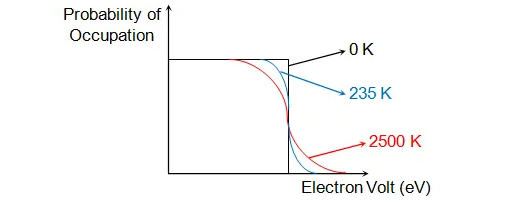
Fig 18. Fermi-Dirac distribution function at different temperatures
The electrons have little energy and hence inhabit lower energy states at T = 0 K. The Fermi-level is the highest energy state among these inhabited levels. As a result, electrons do not occupy any energy levels above the Fermi level. As a result, as indicated by the black curve in Figure, we get a step function that defines the Fermi-Dirac distribution function.
However, when the temperature rises, the electrons gather more and more energy, eventually reaching the conduction band. As a result, at higher temperatures, it is difficult to discriminate between the occupied and unoccupied states, as seen by the blue and red curves in Figure.
The free electrons in a solid crystal have different energies. According to quantum theory, free electrons continually occupy distinct energy levels at absolute zero temperature, with no gaps between filled states. Dropping the free electrons of a metal one by one into the potential well demonstrates this. The first electron to be dropped would occupy the lowest accessible energy level, say E0, and the following electron would do the same. The following energy level would be occupied by the third electron. Because of Pauli's exclusion principle, the third electron dropped would occupy the energy level E1 (>E0), and so on. If there are N (even) electrons in the metal, they will be dispersed in the first N/2 energy levels, with the higher energy levels being completely empty, as seen in Fig.
Figure Distribution of electrons in various energy levels at 0 K.
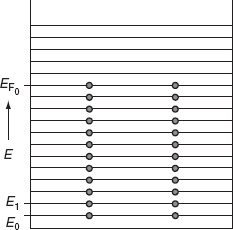
The highest filled level, which separates the filled and empty levels at 0 K is known as the Fermi level and the energy corresponding to this level is called Fermi energy (EF). Fermi energy can also be defined as the highest energy possessed by an electron in the material at 0 K. At 0 K, the Fermi energy EF is represented as EF0. As the temperature of the metal is increased from 0 K to TK, then those electrons which are present up to a depth of KBT from Fermi energy may take thermal energies equal to KBT and occupy higher energy levels, whereas the electrons present in the lower energy levels i.e., below KBT from Fermi level, will not take thermal energies because they will not find vacant electron states.
The probability that a particular quantum state at energy E is filled with an electron is given by Fermi-Dirac distribution function f(E), given by:

A graph has been plotted between f(E) and E, at different temperatures 0 K, T1 K, T2 K, T3 K.
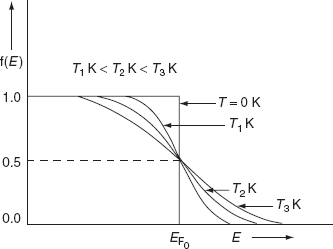
Analytical Treatment At 0 K: Substitute T = 0 K in the Fermi-Dirac distribution, we have

= 0 for E > EF
The curve has step-like character with f(E) = 1 for energies below EF0 and f(E) = 0 for energies above EF0. This represents that all the energy states below EF0 are filled with electrons and all those above it are empty.
At T > 0 K

> 0 for E > EF
= ½ for E = EF
As the temperature is raised from absolute zero to T1K, the distribution curve begins to departs from step-like function and tails off smoothly to zero. Again with a further increase in temperature to T2K and to T3K, the departure and tailing of the curves increases. This indicates that more and more electrons may occupy higher energy states with an increase of temperature and as a consequence the number of vacancies below the Fermi level increases in the same proportion. At non-zero temperatures, all these curves pass through a point whose f(E) =1/2, at E = EF . So EF lies half way between the filled and empty states.
In physics, a degenerate gas is a particular configuration of a gas made up of subatomic particles with half-integral intrinsic angular momentum that is frequently obtained at high densities (spin). Fermions are particles whose microscopic behaviour is governed by a set of quantum mechanical principles known as Fermi-Dirac statistics (q.v.). These principles specify, for example, that any quantum-mechanical state of a system can only have one fermion. Because the lower-energy states have all been filled, the extra fermions are forced to inhabit states of higher and higher energy as particle density rises. The pressure of the fermion gas rises as the higher-energy states gradually fill in, a phenomenon known as degeneracy pressure. A fully degenerate, or zero-temperature, fermion gas is one in which all of the energy levels below a certain value (named Fermi energy) are filled. All fermions, including electrons, protons, neutrons, and neutrinos, follow Fermi-Dirac statistics. Degenerate electron gas can be found in common metals and in the interiors of white dwarf stars, for example.
We'll look at a gas of fermions in the degenerate regime, where the density n exceeds the quantum density n q by a large factor, or when the Fermi energy exceeds the temperature by a large factor. We've seen that for such a gas, is positive, therefore we'll focus on the Fermi energy EF, which is near to its T=0 value.
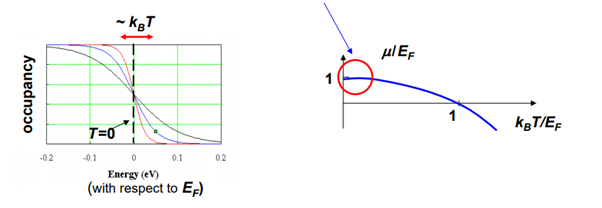

The electron gas in metals and white dwarf stars is the most important degenerate Fermi gas. Another example is a neutron star with such a high density that the neutron gas is degenerate.
3.8.1 Degenerate Fermi Gas in Metals
The mobile electrons in the conduction band that can participate in charge transport are considered. The energy is measured from the conduction band's bottom. When metal atoms come together, their outer electrons separate and are free to flow through the solid. With the concentration of beneficial metals ~ 1 electron/ion, the density of electrons in the conduction band n ~ 1 electron per (0.2 nm) 3 ~ 1029 electrons/m 3 .

The net Coulomb attraction to the positive ions prevents electrons from escaping from the metal; the energy required for an electron to escape (the work function) is typically a few eV. The electrons in a perfect Fermi gas are trapped between impenetrable walls, according to the model.
Why may this dense gas be treated as ideal? Indeed, at this density, Coulomb interactions between electrons must be exceedingly strong, because electrons in a solid travel in the strong electric fields of positive ions. Landau's Fermi liquid theory addresses the first problem. The response to the second issue is that, while the ion field changes the density of states and the effective mass of electrons, it has no influence on the ideal gas approximation's validity. Thus, in the case of “simple” metals, it is reasonable to treat mobile charge carriers as electrons with mass renormalized slightly by interactions. However, there are situations when interactions result in mass enhancements of 100-1000 times (“heavy fermions”).
3.8.2 The Fermi Energy
The density of states per unit volume for a 3D free electron gas (m is the electron mass):

The number of electron per unit volume:

At T = 0, all the states up to ε = EF are filled, at ε> EF – empty:



The Fermi energy (μ of an ideal Fermi gas at T=0)



At room temperature, this Fermi gas is strongly degenerate (EF>>kBT).
The total energy of all electrons in the conduction band (per unit volume):

- a very appreciable zero-point energy!
Key takeaway:
A fully degenerate, or zero-temperature, fermion gas is one in which all of the energy levels below a certain value (named Fermi energy) are filled.
Fermi-Dirac statistics apply to fermions, which include electrons, protons, neutrons, and neutrinos.
When the mass of a degenerate gas increases, the particles become closer together due to gravity (and the pressure rises), and the object shrinks.
3.9.1 Density of Energy States
The Fermi function calculates the likelihood of occupying an available energy level, however the number of possible energy states must be multiplied by the number of electrons in the conduction band. This density of states is the same as the electron density of states, but the implications for conductors and semiconductors are different. The density of states for the conductor can be thought of as starting at the bottom of the valence band and filling up to the Fermi level, but because the conduction band and valence band overlap, the Fermi level is in the conduction band, which means there are plenty of electrons available for conduction. The density of states in the semiconductor is the same, but the density of states for conduction electrons starts at the top of the gap.

3.9.2 Introduction
In a semiconductor, the density of electrons is proportional to the density of possible states and the likelihood that each of these states is occupied. The product of the density of states and the Fermi-Dirac probability function (also known as the Fermi function) yields the density of occupied states per unit volume and energy:
n(E) = gC (E) f(E) (f46)
Because holes in the valence band correspond to empty states, the likelihood of having a hole equals the likelihood that a specific state is not filled, resulting in a hole density per unit energy of:
p(E) = gv (E) [ 1 – f(E) ] (f47)
The density of carriers is then calculated by multiplying the density of carriers per unit energy by the number of possible energies within a band. The general formulation and an approximate analytic solution for non-degenerate semiconductors are both derived. In addition, the Joyce-Dixon approximation is shown.
3.9.3 3-D Density of states
Solving the Schrödinger equation for the particles in the semiconductor yields the density of states in the semiconductor. Rather than using the actual and complex potential in the semiconductor, the simple particle-in-a-box model is usually used, in which the particle is assumed to be free to move within the material. For this and other more sophisticated models, the boundary conditions, which describe the fact that particles cannot leave the material, cause the density of states in k-space to stay constant. If the E-k relation is known, the density of states corresponding to it can be found. For a comprehensive derivation in one, two, and three dimensions, the reader should refer to the section on density of states.
The density of states in three dimensions for an electron that behaves as a free particle with effective mass, m*, is given by:
 (f24a)
(f24a)
Ec is the conduction band's lowest point, below which the density of states is zero. For holes in the valence band, the density of states is given by:
 (f24b)
(f24b)
3.9.4 The Fermi function
The Fermi-Dirac probability density function calculates the likelihood of a fermion in thermal equilibrium with a large reservoir occupying a certain energy level. Fermions are particles that have a half-integer spin (1/2, 3/2, 5/2, etc.). The Pauli exclusion principle asserts that only one fermion can occupy a state specified by its set of quantum numbers n,k,l, and s. This is a unique property of fermions. As a result, particles that obey the Pauli exclusion principle could likewise be classified as fermions. All of these particles have a half-integer spin as well.
Both electrons and holes have a spin of 1/2 and follow Pauli's exclusion principle. These particles will fill the available states in an energy band when they are added to it, just like water fills a bucket. The lowest-energy states are filled first, followed by the next higher-energy levels. The energy levels are all filled up to a maximum energy, which we call the Fermi level, at absolute zero temperature (T = 0 K). There are no states filled above the Fermi level. The transition between entirely filled and completely empty states is gradual rather than sudden at higher temperatures. This behaviour is described by the Fermi function, which is:
 (f18)
(f18)
In the graph below, this function is plotted at ambient temperatures of 150 K (red curve), 300 K (blue curve), and 600 K. (black curve).
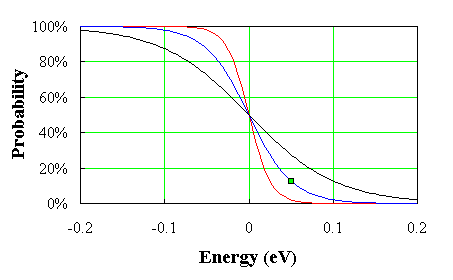
Fig 19. T = 150 K (red curve), 300 K (blue curve), and 600 K Fermi-Dirac distribution function (black curve).
For energies more than a few times kT below the Fermi energy, the Fermi function has a value of one, equals 1/2 if the energy equals the Fermi energy, and declines exponentially for energies a few times kT bigger than the Fermi energy. While the Fermi function equals a step function at T = 0 K, the transition at finite temperatures and higher temperatures is more gradual.
The section on distribution functions has a more extensive description of the Fermi function and other distribution functions.
3.9.5 General expression
Integrating the product of the density of states with the probability density function over all possible states yields the general equation for carrier density in a semiconductor. The integral is calculated for electrons in the conduction band from the bottom of the conduction band, labelled Ec, to the top of the conduction band, as shown in the equation below:
top of the conduction band top of the conduction band
 (f48)
(f48)
The density of states in the conduction band is Nc(E), and the Fermi function is f(E).
The graphic below shows this general equation for a parabolic density of states function with Ec = 0. The density of states function (green curve), the Fermi function (blue curve), and their product, which is the density of electrons per unit volume and per unit energy, n(E), are shown in the figure (red curve). Under the red curve, the integral corresponds to the crosshatched area.
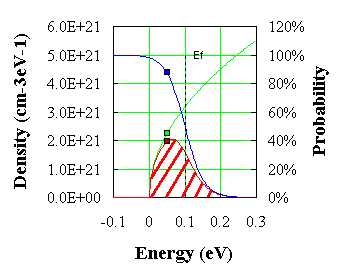
Fig 20. The integral of carrier density. The density per unit energy, n(E), and the probability of occupancy, f(E), are shown (blue curve). The cross-hatched area under the red curve equals the carrier density.
Because the Fermi function approaches 0 at energies greater than a few kT above the fermi energy EF, the actual top of the conduction band does not need to be known, therefore the upper limit can be infinity without changing the integral, yielding:
 (f53)
(f53)
For a three-dimensional semiconductor this integral becomes:
 (f54)
(f54)
While we can't solve this integral analytically, we can get a numeric answer or an approximate analytical answer. In the same way, one obtains holes:
 (f56)
(f56)
And
 (f57)
(f57)
These equations were used to obtain the figure 2.5.2.
3.9.6 Approximate expressions for non-degenerate semiconductors
Non-degenerate semiconductors are those in which the Fermi energy is at least 3 kT distant from either band edge. We limit ourselves to non-degenerate semiconductors since this definition allows us to replace the Fermi function with a simple exponential function. After that, the carrier density integral can be calculated analytically to give:

(f55)
With
 (f5)
(f5)
Where Nc is the effective density of states in the conduction band. Similarly for holes one can approximate the hole density integral as:
 (f58)
(f58)
With
 (f6)
(f6)
Where Nv is the effective density of states in the valence band.
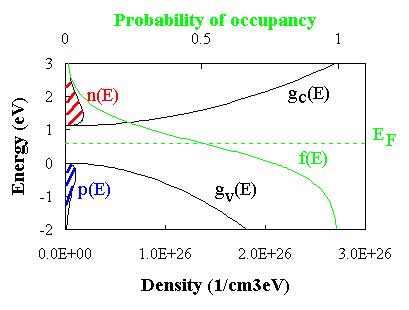
Fig 21. The density of states and carrier densities in the conduction and valence band. Shown are the electron and hole density per unit energy, n(E) and p(E), the density of states in the conduction and valence band, gc(E) and gc(E) and the probability of occupancy, f(E), (green curve). The electron (hole) density equals the red (blue) cross-hatched area
3.9.7 Approximate expressions for degenerate semiconductors
Joyce and Dixon discovered a useful approximate expression for relating the carrier density to the Fermi energy of degenerate semiconductors, which is:
 (f51)
(f51)
For electrons and by:
 (f52)
(f52)
Key takeaway:
The number of solutions to Schrödinger's equation equals the density per unit volume and energy of the number of states in a semiconductor.
The well's energy has been set to zero. The density of states is represented by a function g(E), this time a function of energy, with the relation g(E)dE = the number of states per unit volume in the energy range: (E,E+dE). We start by looking at our system as a free electron gas restricted to points k on the surface.
References:
1. Statistical Mechanics, B.K.Agarwal and Melvin Eisner (New Age Inter-national)-2013
2. Thermodynamics, Kinetic Theory and Statistical Thermodynamics: Francis W.Sears and Gerhard L. Salinger (Narosa) 1998
3. Statistical Mechanics: R.K.Pathria and Paul D. Beale (Academic Press)- 2011